Bold strokes of jet-black mulch do more than punctuate a planting bed—they lock in soil moisture, smother weeds, moderate temperature swings, and frame foliage in dramatic contrast. Garden designers lean on this inky backdrop to make greens look lusher, blooms brighter, and pathways crisper while still delivering the practical wins every low-maintenance landscape needs. Whether you’re edging a front border, terracing a slope, or refreshing last season’s tired wood chips, the following twenty ideas show how black mulch can spotlight style and plant health at the same time. Let’s dive into designs that balance curb appeal, sustainability, and everyday function.
1. Brick-Edged Front Border with Black Mulch

A sunny first impression starts at the curb, and a narrow ribbon of precast bricks neatly framing black mulch gives shrubs and annuals an instant, clean outline. The dark ground layer absorbs the afternoon glare so bright coleus, dwarf boxwoods, or seasonal bulbs appear almost spotlighted against it. Lay bricks flush to grade so the mower wheel rides the edge—no tedious string-trimming—and keep mulch two to three inches deep for weed suppression without suffocating roots. Top-dress lightly each spring, and the bed will keep its sharp, graphic definition long after neighboring yards fade into mid-summer chaos.
2. Gravel & Black Mulch Modern Mosaic
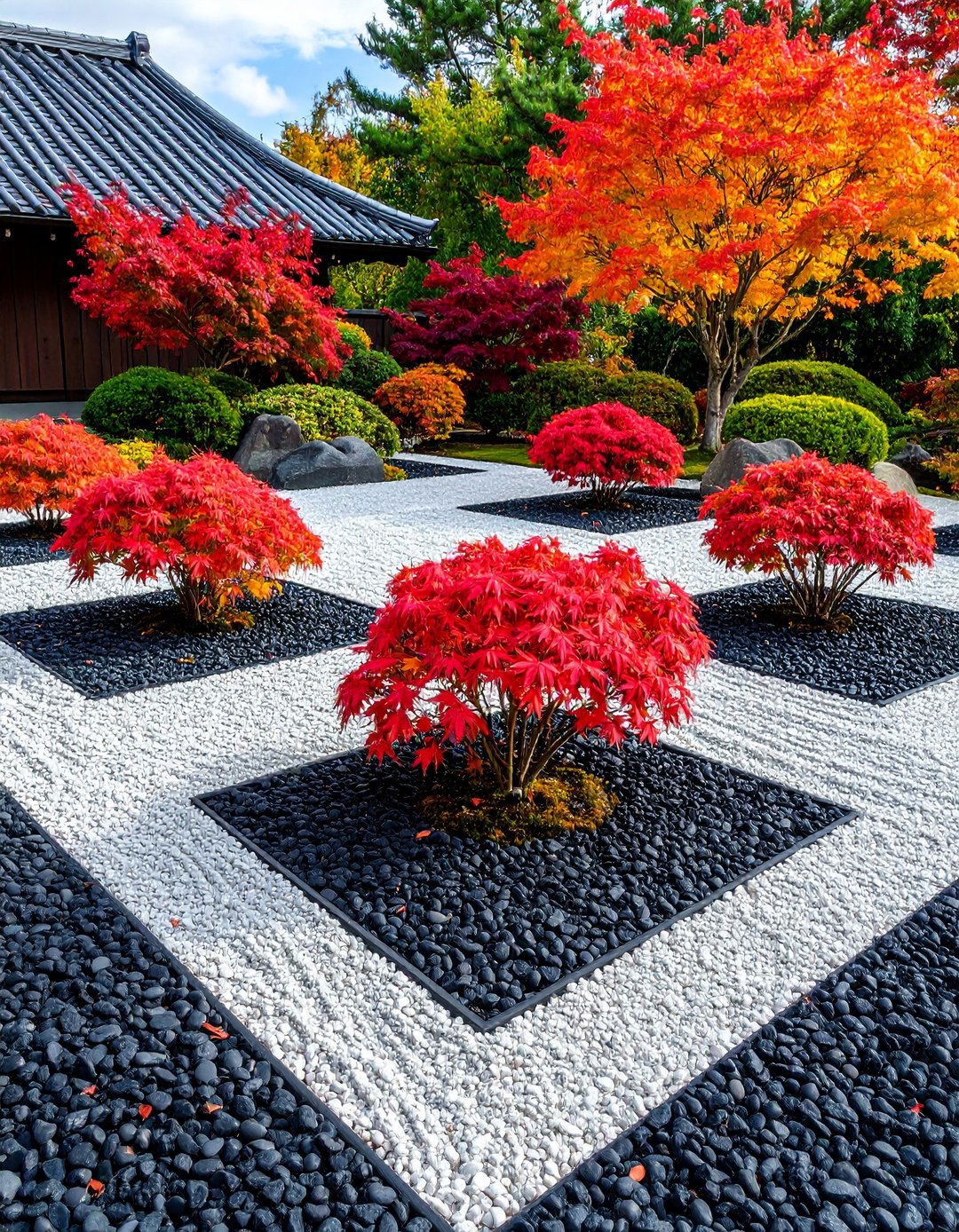
Unlike a single-texture bed, alternating stripes or checkerboards of river gravel and black mulch create a minimalist “living art” floor that complements sleek hardscapes and contemporary architecture. The mulch provides fertile rooting zones for architectural plants—think upright dwarf Japanese maples—while gravel captures roof runoff and reduces splashing on siding. Keep planting pockets generous and install a hidden steel edging strip so materials never drift. Choose cool-gray stones for maximum tonal contrast, then echo that palette in patio furniture or planters to tie the whole vignette together.
3. Hydrangeas & Hostas that Pop on Black Mulch
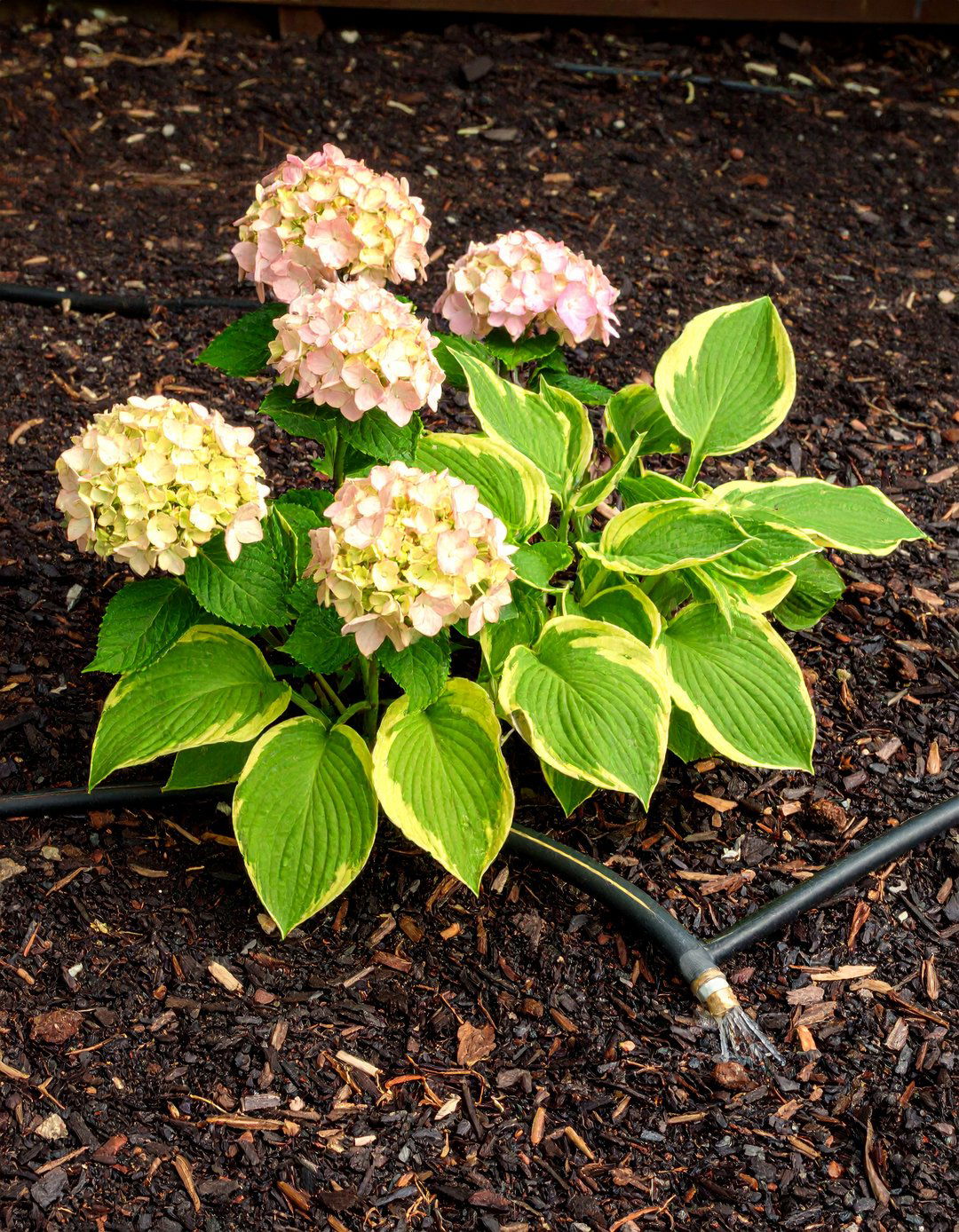
Few combos feel fresher than pastel mop-head hydrangeas billowing over lime-veined hostas, yet both glow brightest when anchored by dark mulch. The near-black background intensifies petal blues and acid-greens while holding the moisture these shade lovers crave. Space plants so mature leaves barely kiss, spread mulch in a smooth five-centimeter layer, and drop a slow-release organic fertilizer under the mat each May for bigger blooms. A discreet soaker hose beneath the mulch supplies even watering and keeps foliage spotless.
4. Native Pollinator Patch Wrapped in Black Mulch
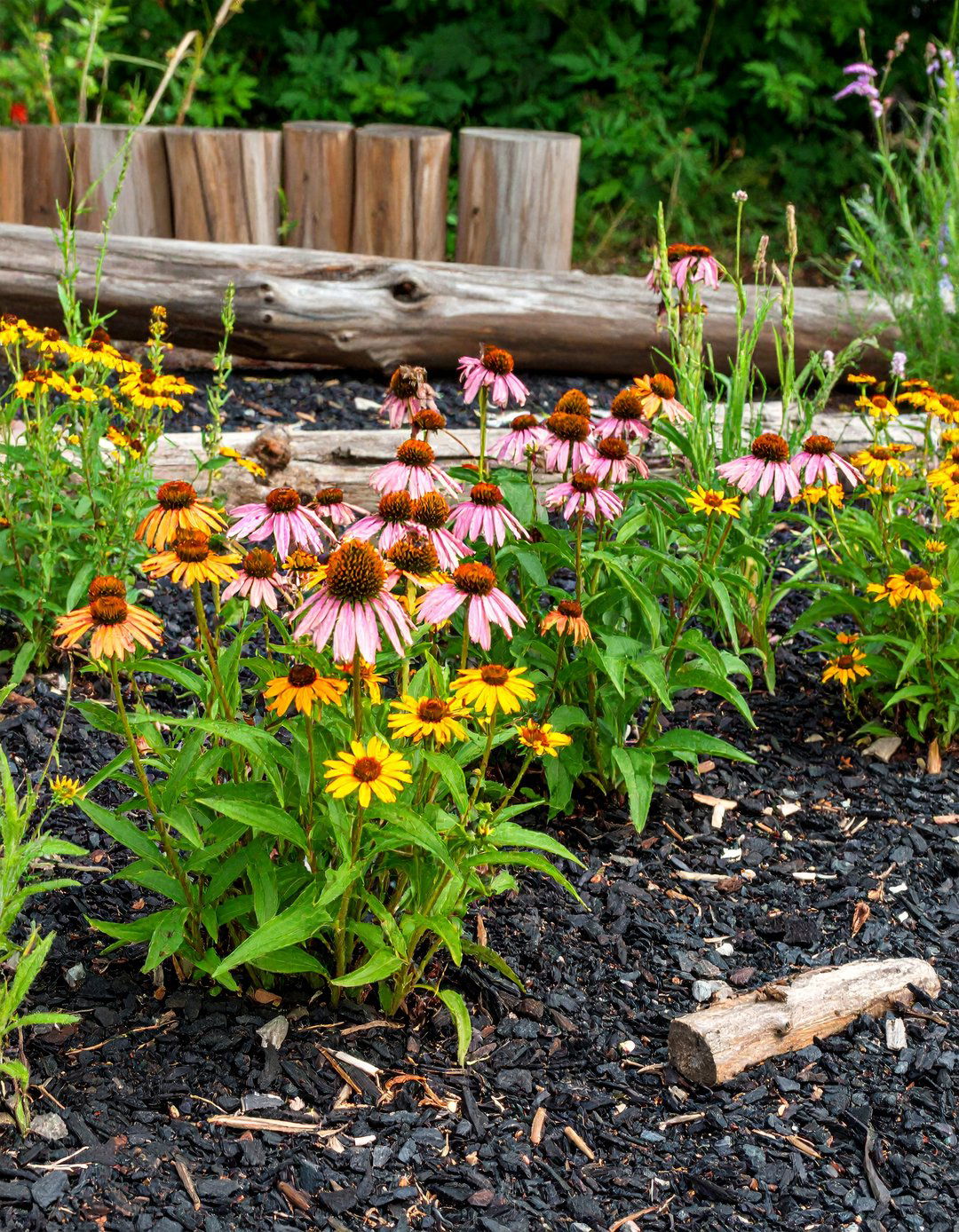
For gardeners chasing ecological impact, a swath of native coneflowers, beardtongue, and little bluestem ringed with black mulch offers nectar stations AND easy upkeep. The mulch knits quickly, suppressing opportunistic weeds that outcompete seedlings, while its heat-trap quality speeds spring soil warm-up so solitary bees emerge right on cue. Edge with reclaimed logs or stone to keep the wild aesthetic, but still refresh the top half-inch every March to bury weed seeds and restore the deep hue migratory butterflies find from a distance.
5. Night-Lit Walkway Accented by Black Mulch
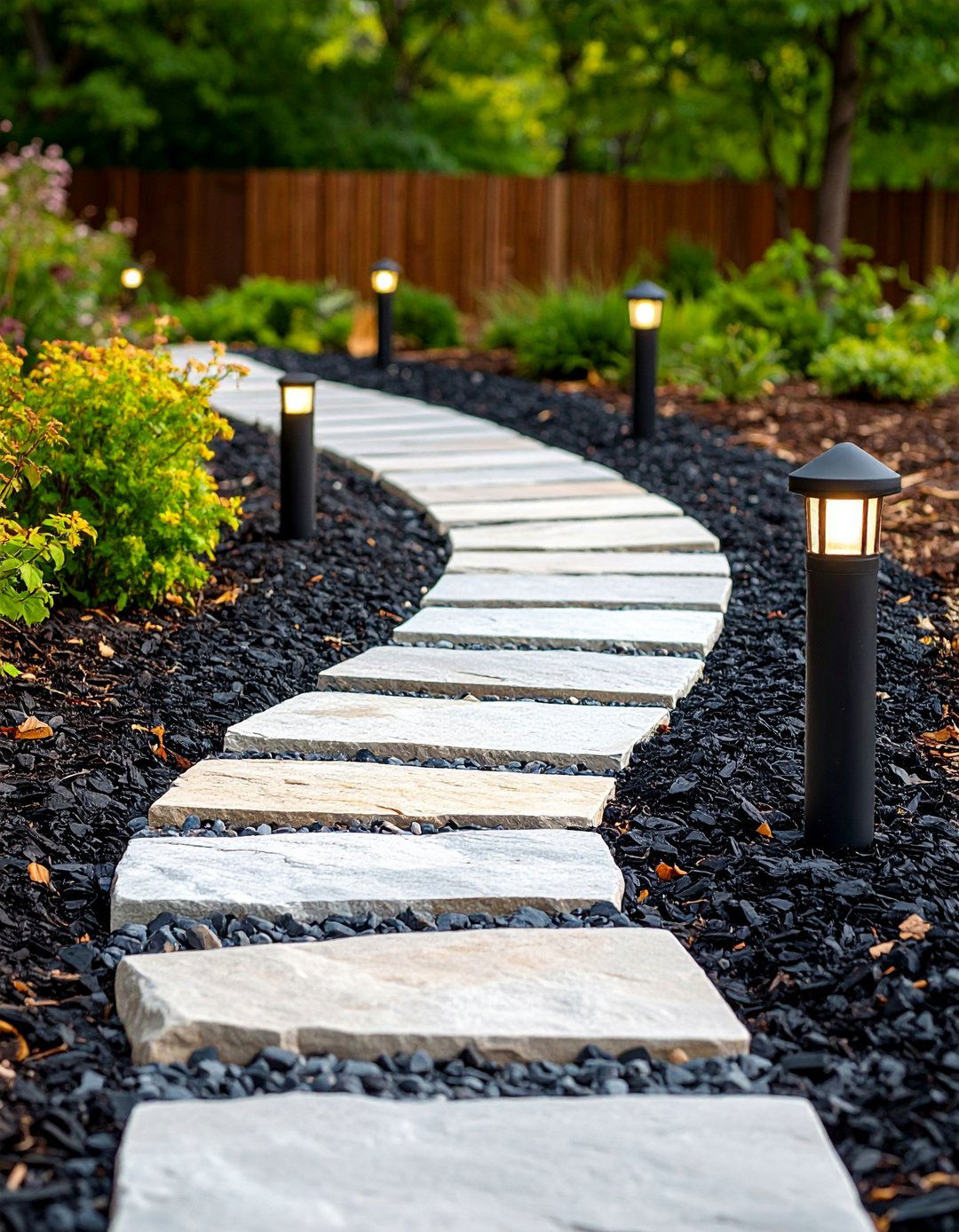
A moonlit stroll feels downright cinematic when low solar path lights bounce off ebony mulch, framing each stepping-stone like a runway. The dark surface hides drip-line tubing and makes inexpensive fixtures beam brighter—great for renters or budget-minded upgrades. Use flexible edging to mirror the path’s curves, drape lights at staggered heights, then mulch right up to the pavers’ edge for a shadow-box effect that guides guests safely after dusk.
6. Raised Vegetable Beds Mulched in Black for Weed-Free Harvests
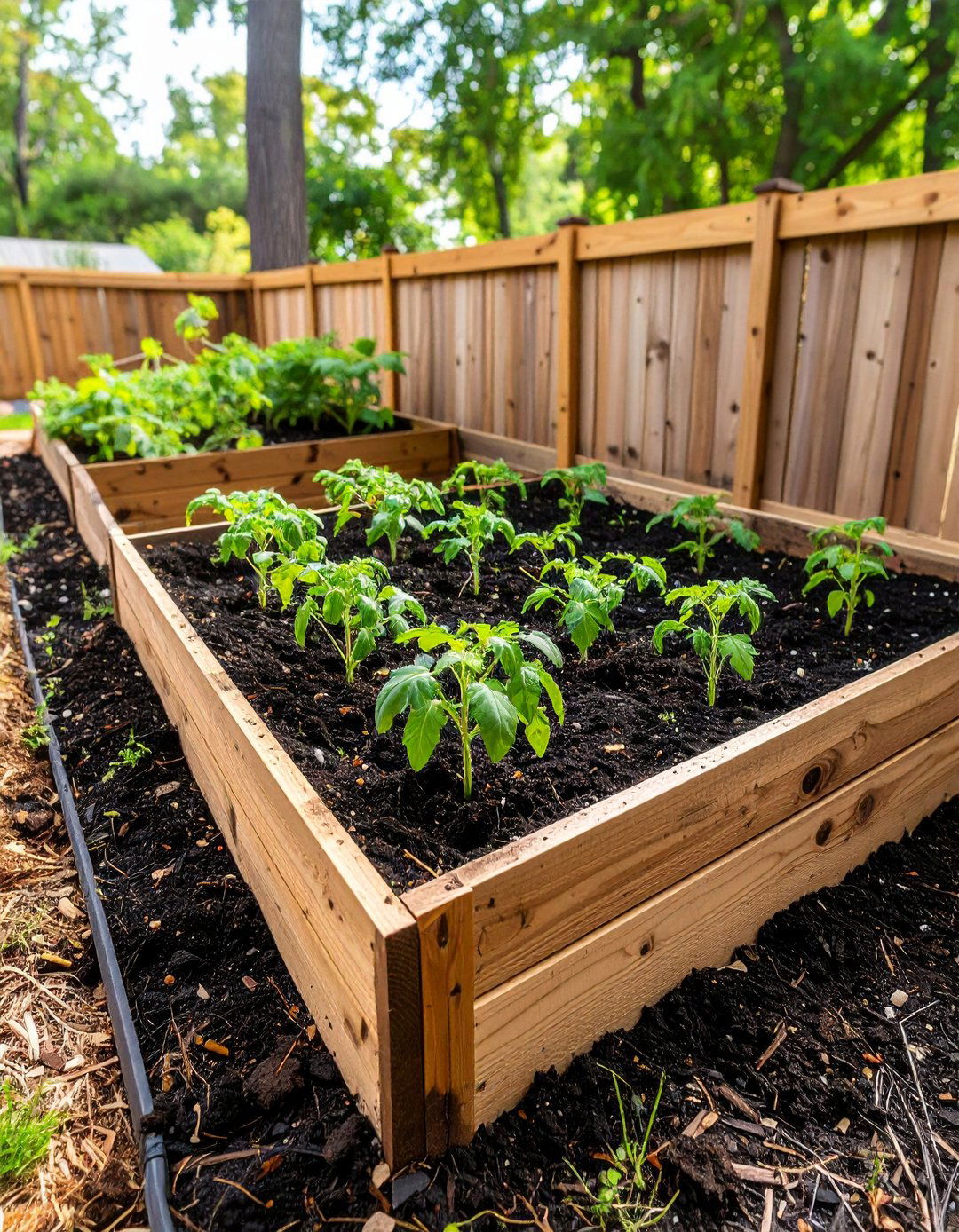
Wood-framed raised beds already warm quicker than ground plots; top them with black mulch and you gain another layer of insulation that speeds germination and blocks weed seeds. After sowing, pull mulch back to expose rows until seedlings stand 5 cm tall, then tuck it back around stems. Water loss drops by up to 25 percent on hot days, meaning less daily irrigation and fewer cracked tomatoes. At season’s end, rake spent mulch into compost or solarize under clear plastic to reuse next year.
7. Terraced Slope Stabilized with Black Mulch Bands

Steep banks often wash bare, but tiering them with short retaining timbers and packing each shelf with coarse hardwood mulch dyed black locks soil in place. Thicker, mat-forming chips resist runoff, especially when pinned with jute netting and groundcovers like creeping juniper. The dark mulch camouflages the net while visually separating the green cascades on each terrace. Tamp chips lightly so rain sinks rather than sheets, and inspect after gully-washer storms to patch thin spots before erosion restarts.
8. Tree-Ring “Donut” of Black Mulch—No Volcanoes Allowed
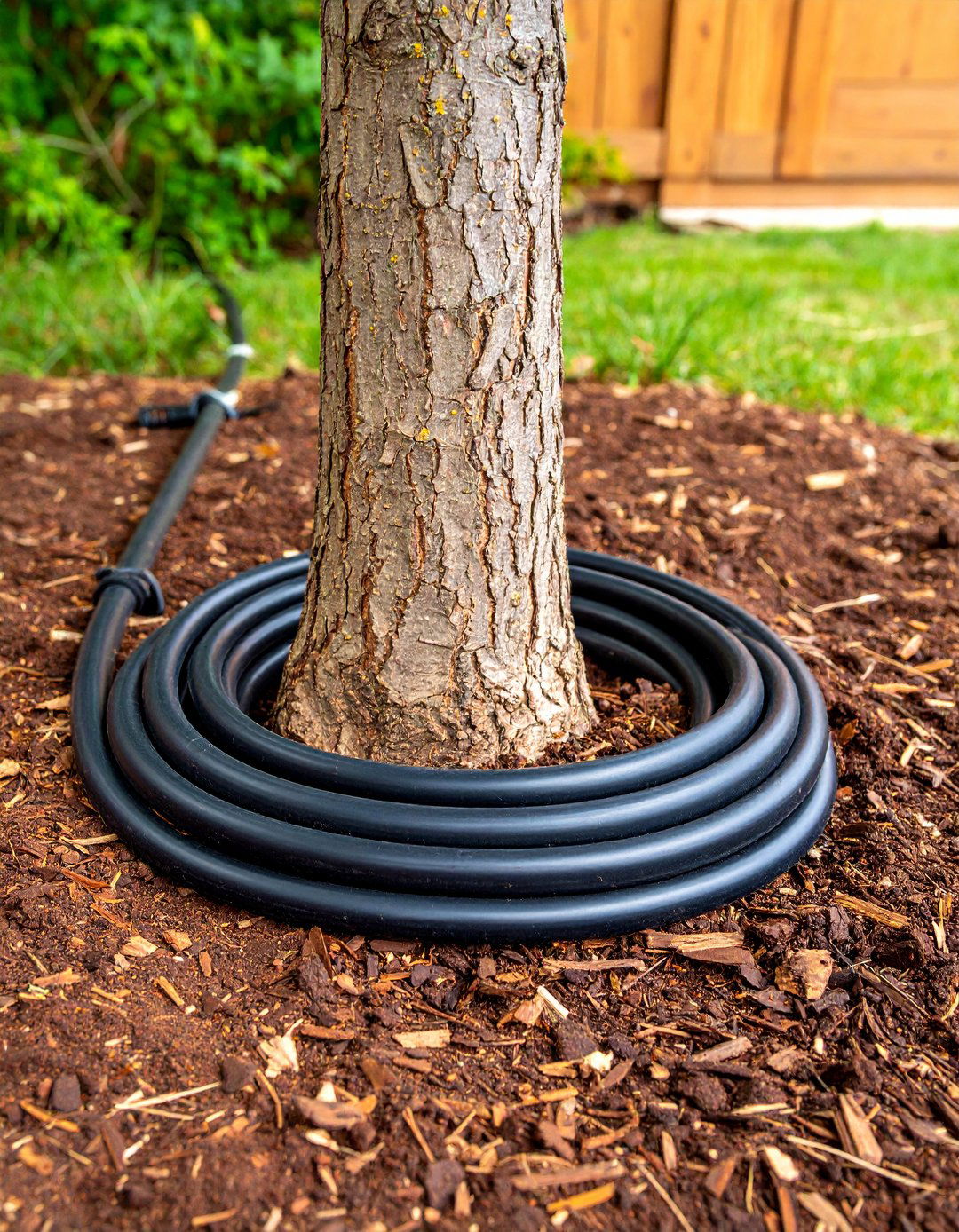
Proper mulching around trunks reduces mower wounds and boosts moisture, yet piling it high (“mulch volcanoes”) suffocates bark. Instead, sculpt a five-to-seven-centimeter-deep black mulch donut that clears the root flare, extending to the drip line for mature shade trees. The dark color absorbs spring sun, helping feeder roots wake earlier, while a hidden soaker loop under the ring delivers slow moisture where roots drink most. Refresh color yearly but remove excess so depth never exceeds ten centimeters.
9. Rubber Black Mulch for Low-Maintenance Play or Pet Zones
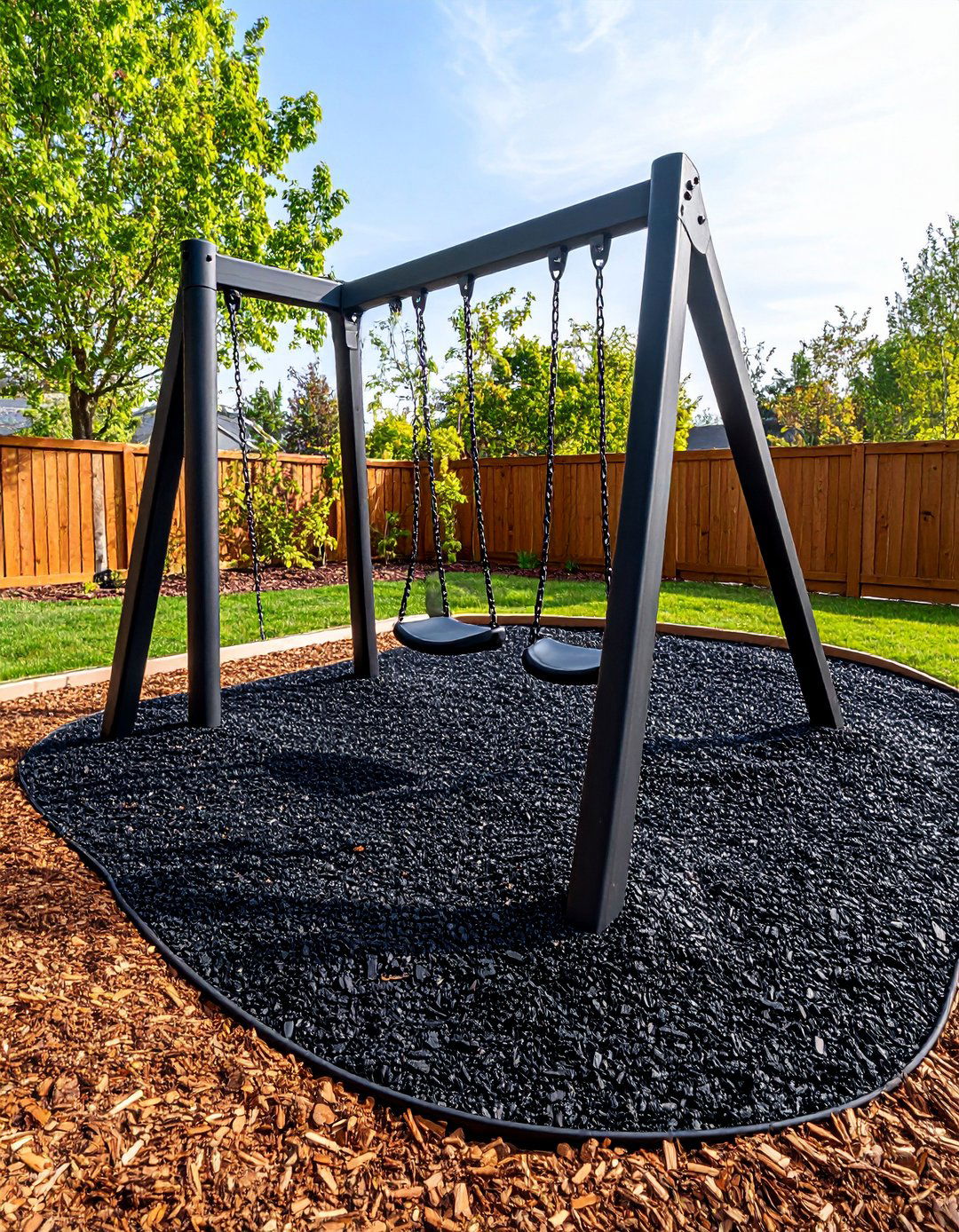
Where splinters spell trouble—under swings or in an off-leash run—recycled-tire mulch in black cushions falls, never decomposes, and drains fast. Its hefty nuggets resist tunneling dogs and seasonal blow-off, cutting annual top-ups compared with wood chips . Install a geotextile fabric beneath to block persistent weeds, rake smooth quarterly to maintain even safety depth, and hose spills; pigments used meet playground safety standards, but confirm supplier certifications when pets chew everything.
10. Container-Cluster Courtyard Set on Black Mulch Carpet
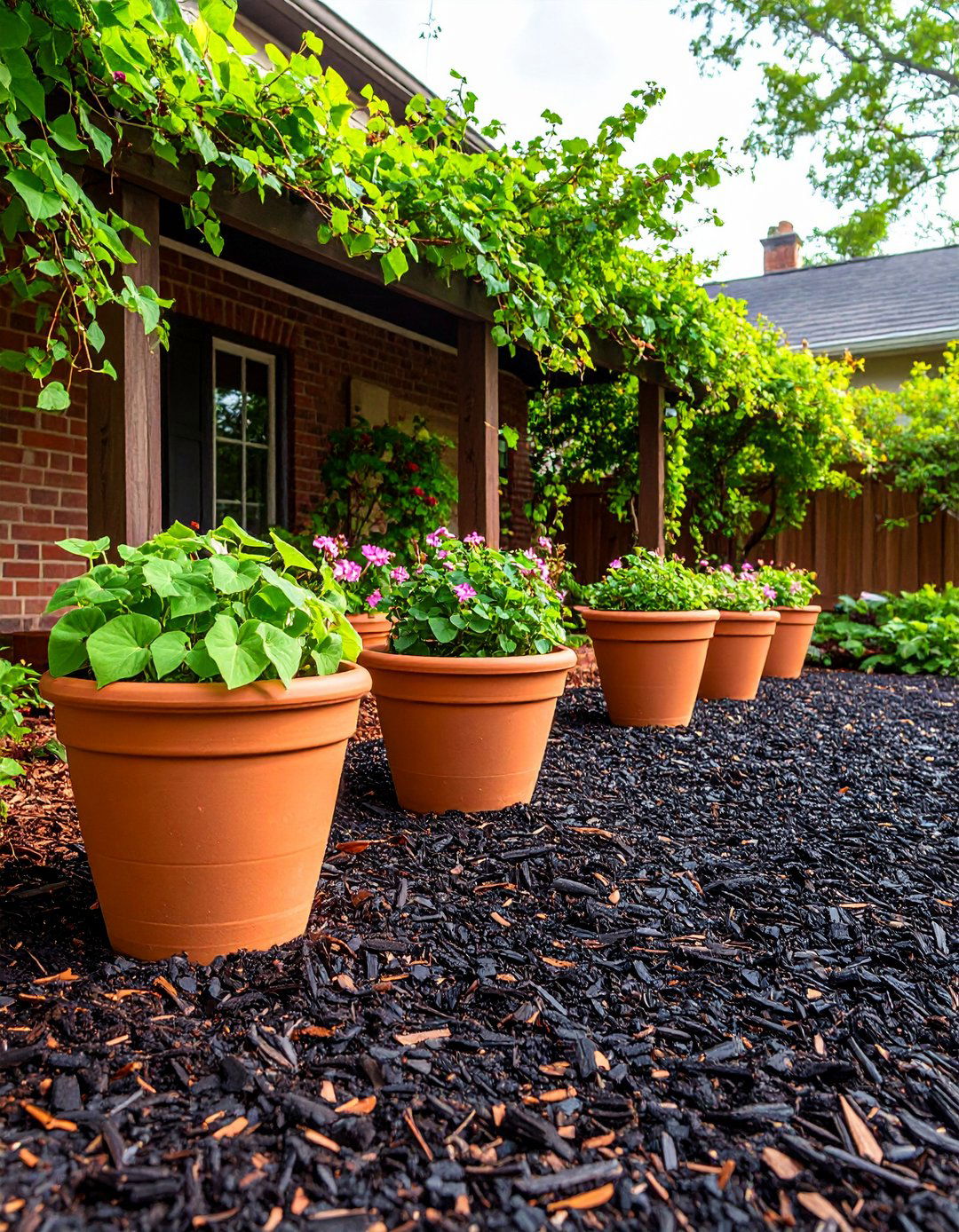
A patio crowded with terra-cotta pots can look scattered; laying a continuous field of black mulch beneath unifies the vignette and masks drip stains. Plant spillers like sweet potato vine in containers so foliage arcs over the black floor, softening lines yet spotlighting leaf color. Keep a two-centimeter gap between pot base and mulch to deter root-rot, and use a handheld blower weekly—mulch won’t fling like gravel but sheds fallen petals in seconds.
11. Zen Strip of Ornamental Grass, Rock & Black Mulch
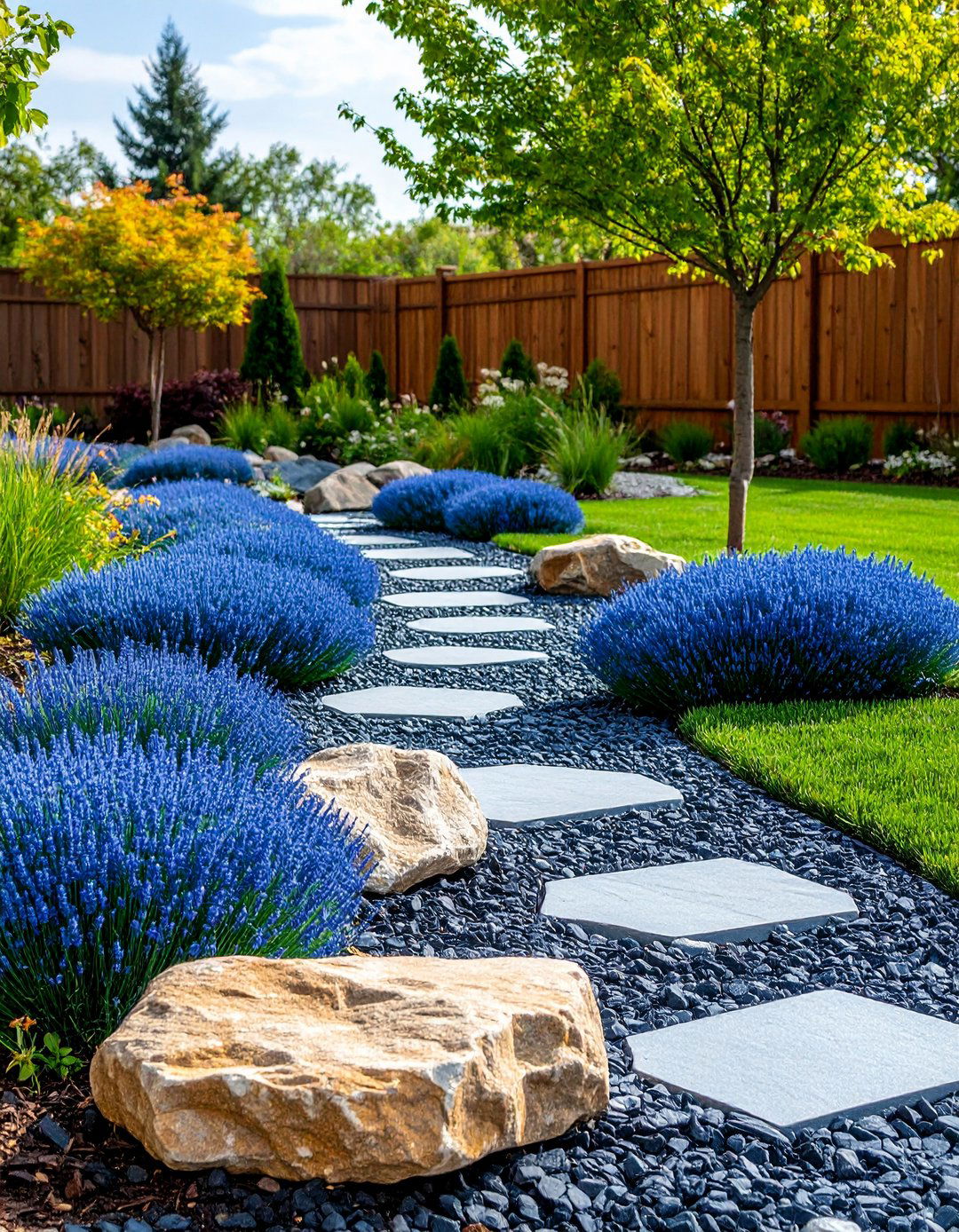
Want instant calm beside a deck? Combine clumping blue fescue, a handful of weathered granite boulders, and a silky bed of black mulch for a low-water nod to Japanese dry gardens. The black amplifies feathery grass silhouettes while catching evening uplights for a subtle glow. Rake mulch into flowing lines that echo wind patterns, then thin any self-seeding weeds promptly so the minimalist rhythm stays pristine.
12. Seasonal Color Swaps Made Bolder by Black Mulch
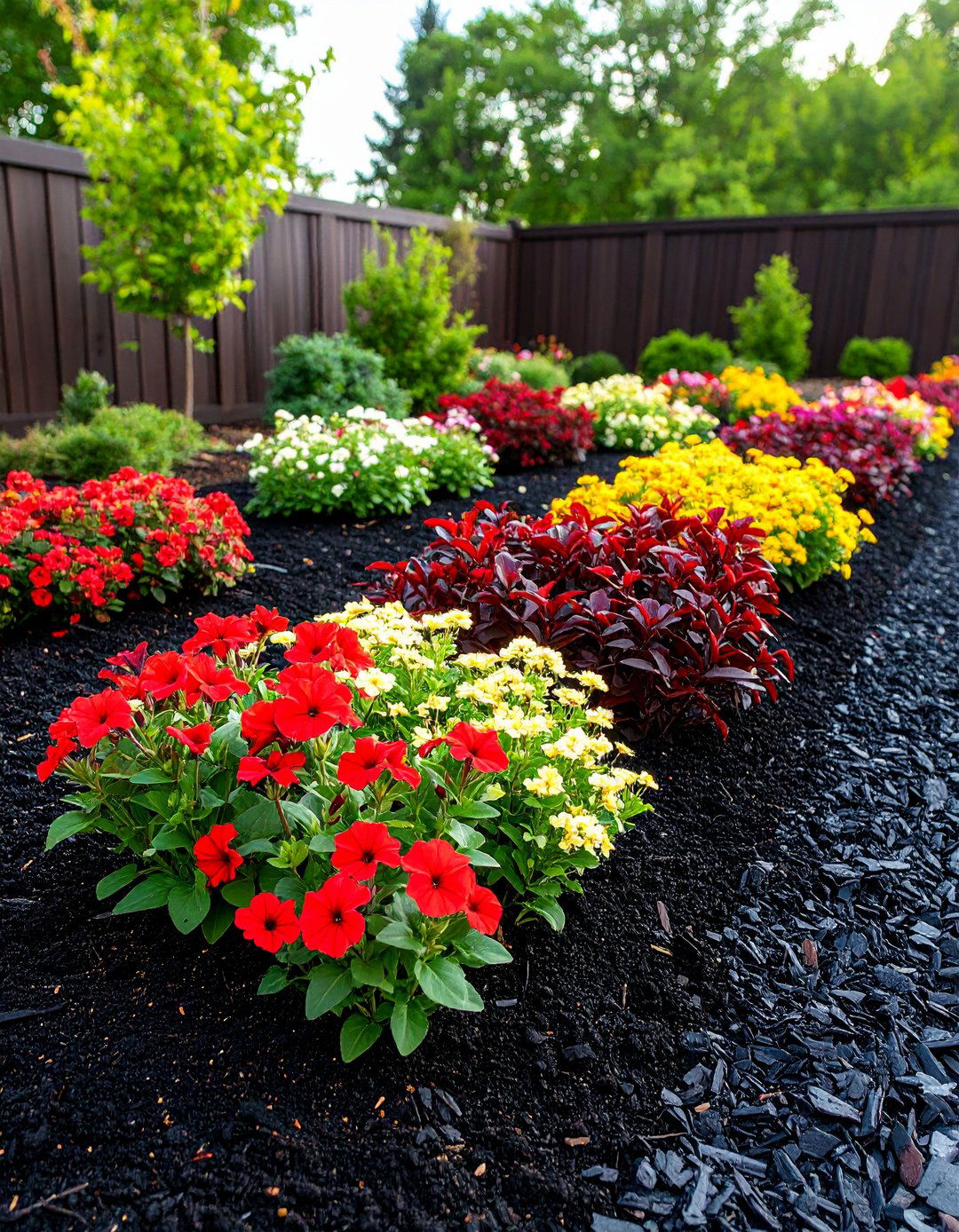
Gardeners who overhaul beds each spring and fall know fresh annuals shine harder against ebony mulch, whose neutral base flexes with every palette. Dark tones deepen reds, neons, even pastels, giving store-bought flats an immediate designer polish. Because dyed chips fade in UV exposure, rotate or top-dress a half-inch after 12 months for uninterrupted saturation and to bury spent petunia litter before cold sets in.
13. Sustainable Recycled-Wood Black Mulch Reduces Waste
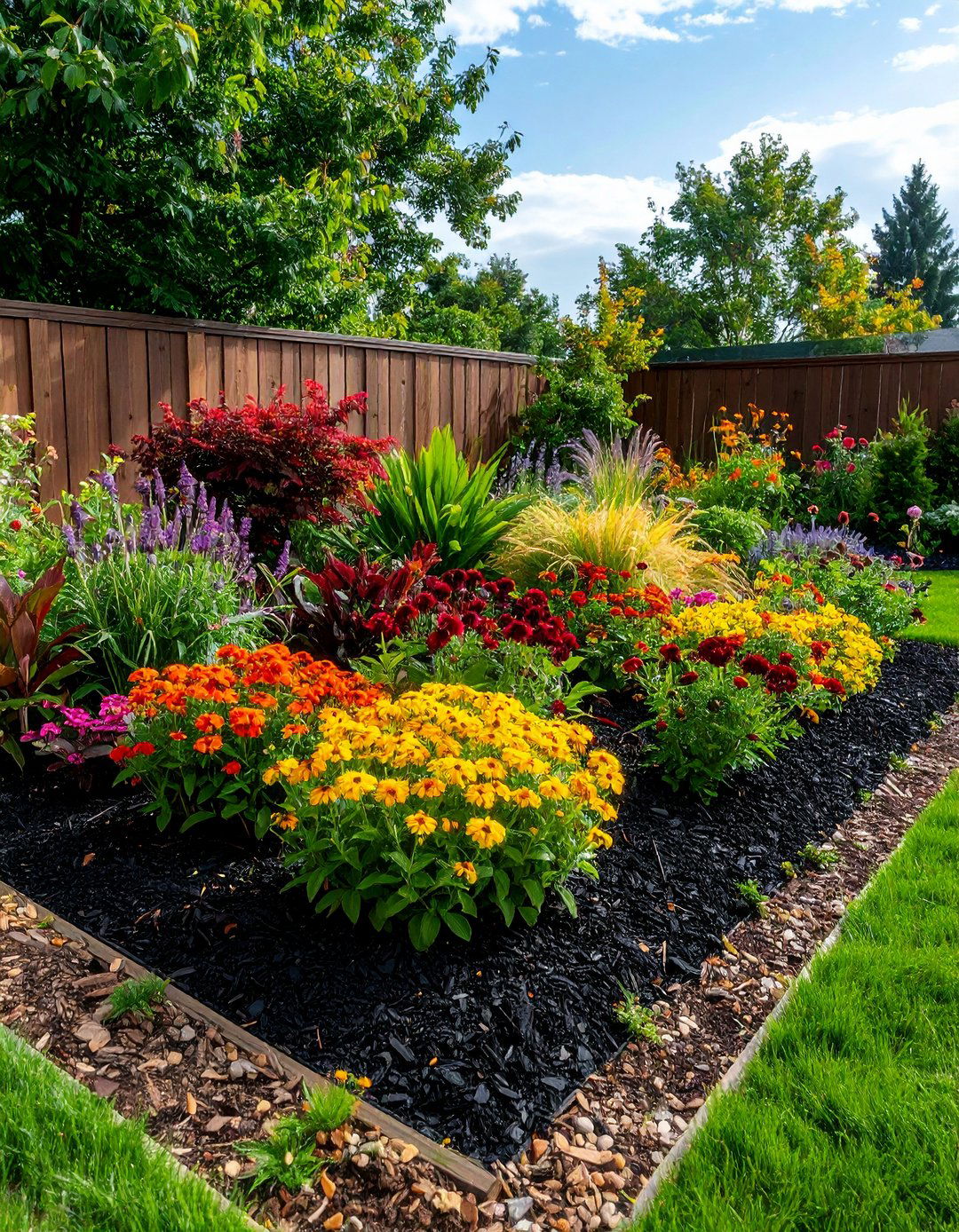
Choosing mulch made from clean, kiln-dried pallet scrap diverts lumber from landfills while delivering the same moisture savings as virgin bark. Many products use carbon-based pigments deemed plant-safe; just verify lumber sources are free of pressure-treated residues for long-term soil health. Spread a thin test layer, water well, then check for odor or residue before committing across edible beds.
14. Herb Edge Warmed by Heat-Absorbing Black Mulch
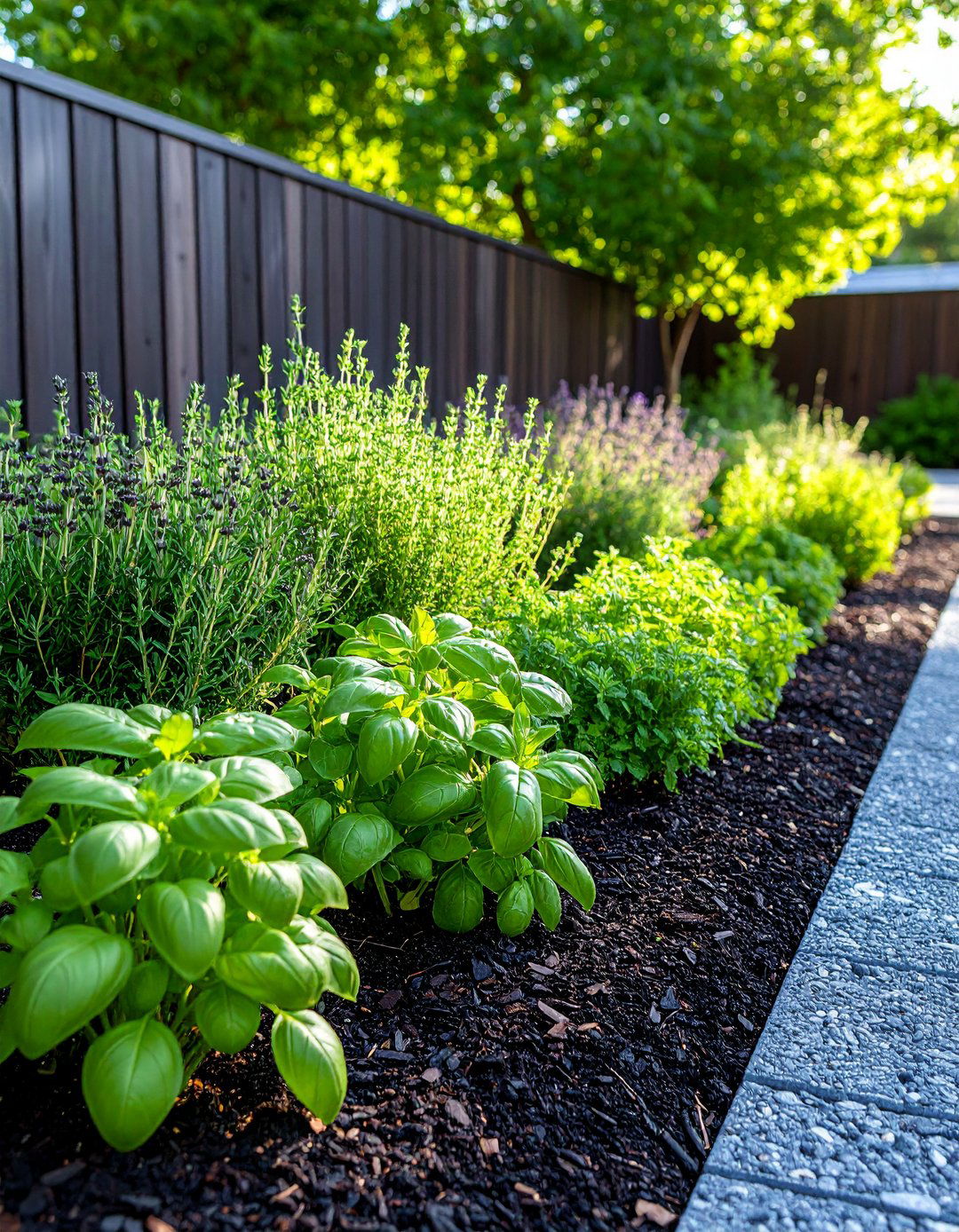
Black mulch’s solar gain raises soil temps by several degrees—welcome news for Mediterranean herbs that disdain cold springs. Basil, thyme, and sage planted along a walkway root faster and release more essential oils when their base stays toasty yet moist. Keep layers thin (about five centimeters) so crowns don’t stay drenched overnight, and harvest outer stems frequently; vigorous regrowth hides any inevitable late-season fading.
15. Xeriscape Bed Conserving Water with Black Mulch Blanket
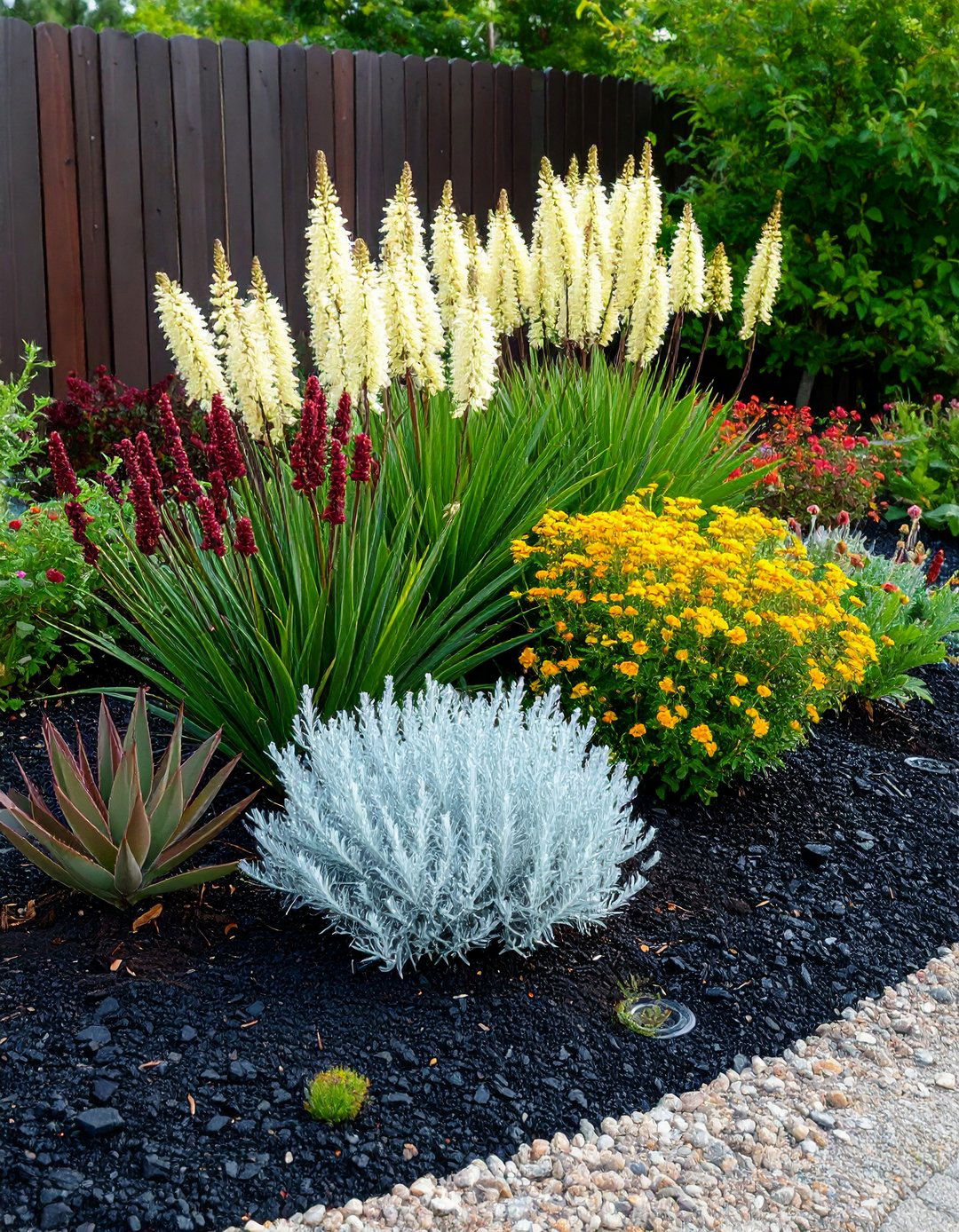
In arid zones, pairing drought-tough perennials with deep black mulch slashes evaporation by up to a quarter compared to bare soil—an easy win when watering bans bite. Combine agastache, yucca, and silvery artemisia for textural drama, and group by water needs to micro-target drip emitters hidden beneath the mulch. A twice-yearly fluff with a metal rake breaks crusts so thunderstorms penetrate rather than run off.
16. Moody Monochrome Garden of Dark Foliage & Black Mulch
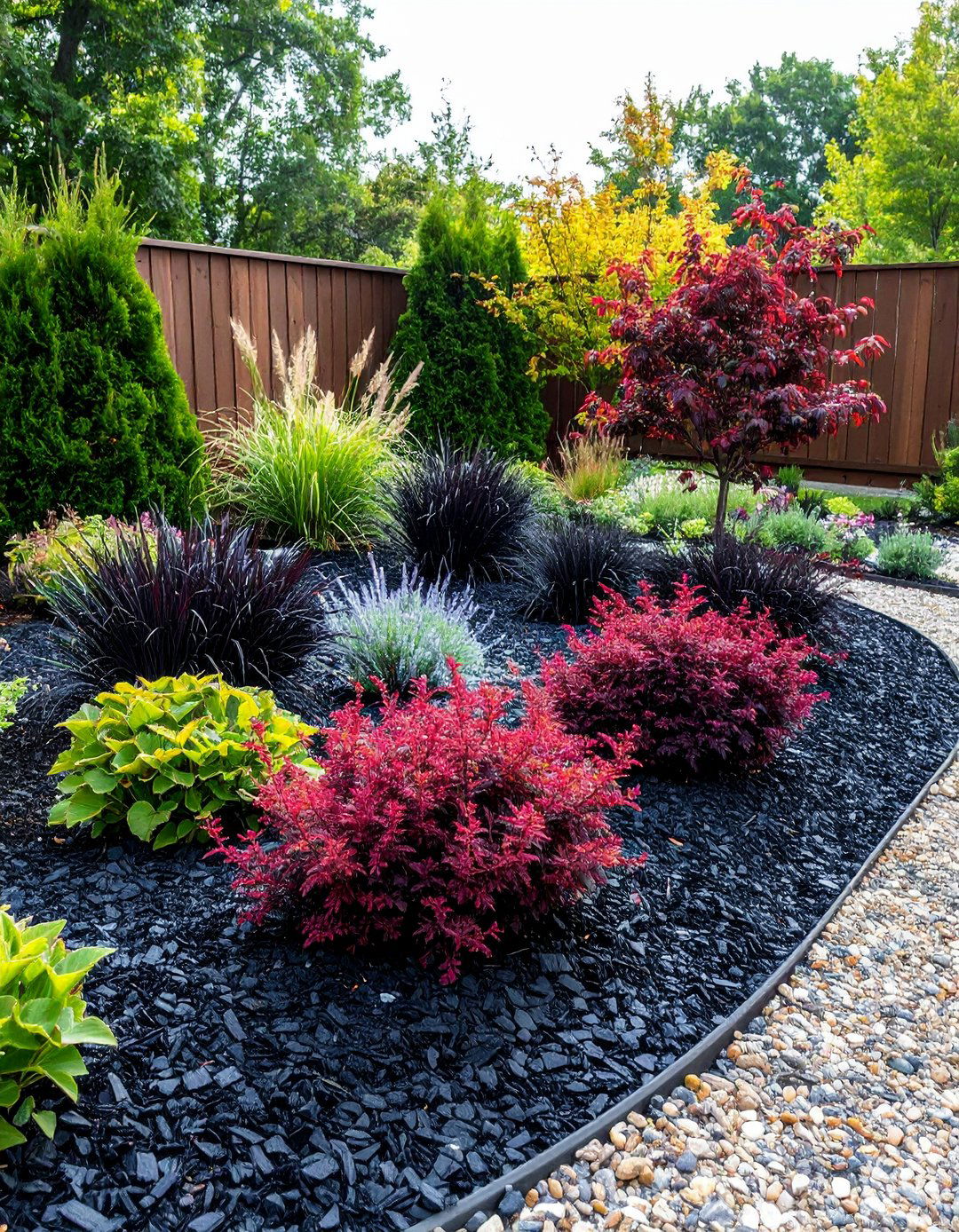
Surprisingly, pairing charcoal heuchera, black mondo grass, and burgundy loropetalum with black mulch creates a layered, moody tableau instead of a flat void. Subtle shifts in gloss and texture keep the viewer’s eye moving, while light-colored hardscape or café lights provide essential sparkle. Use contrasting leaf shapes—strappy, lobed, tiny—to avoid visual mud, and refresh mulch edges frequently since stray lawn clippings dull the drama fast.
17. Chalkboard-Theme Kids’ Plot Backed by Black Mulch
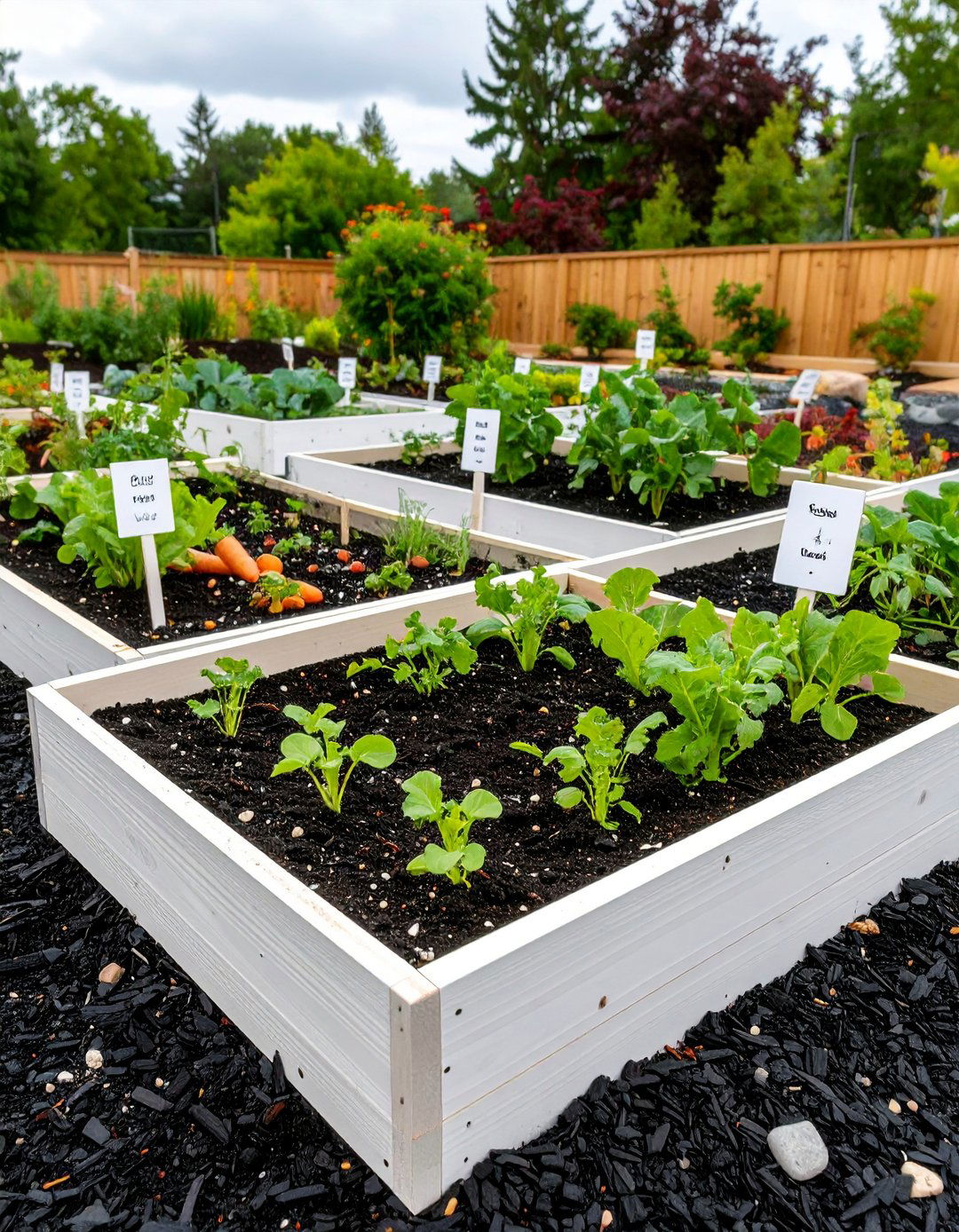
Kids love labeling veggies; black mulch mimics a chalkboard so white plant markers or doodled stones pop. Choose non-toxic, larger-chip mulch that is harder to swallow for curious toddlers, and keep the depth shallow around seedlings. As plants mature, the dark base highlights growth progress, turning daily watering into a science lesson. Encourage young gardeners to turn the mulch lightly with gloved hands—great tactile play that also aerates the bed.
18. Low-Maintenance Island Beds of Black Mulch in Open Lawn
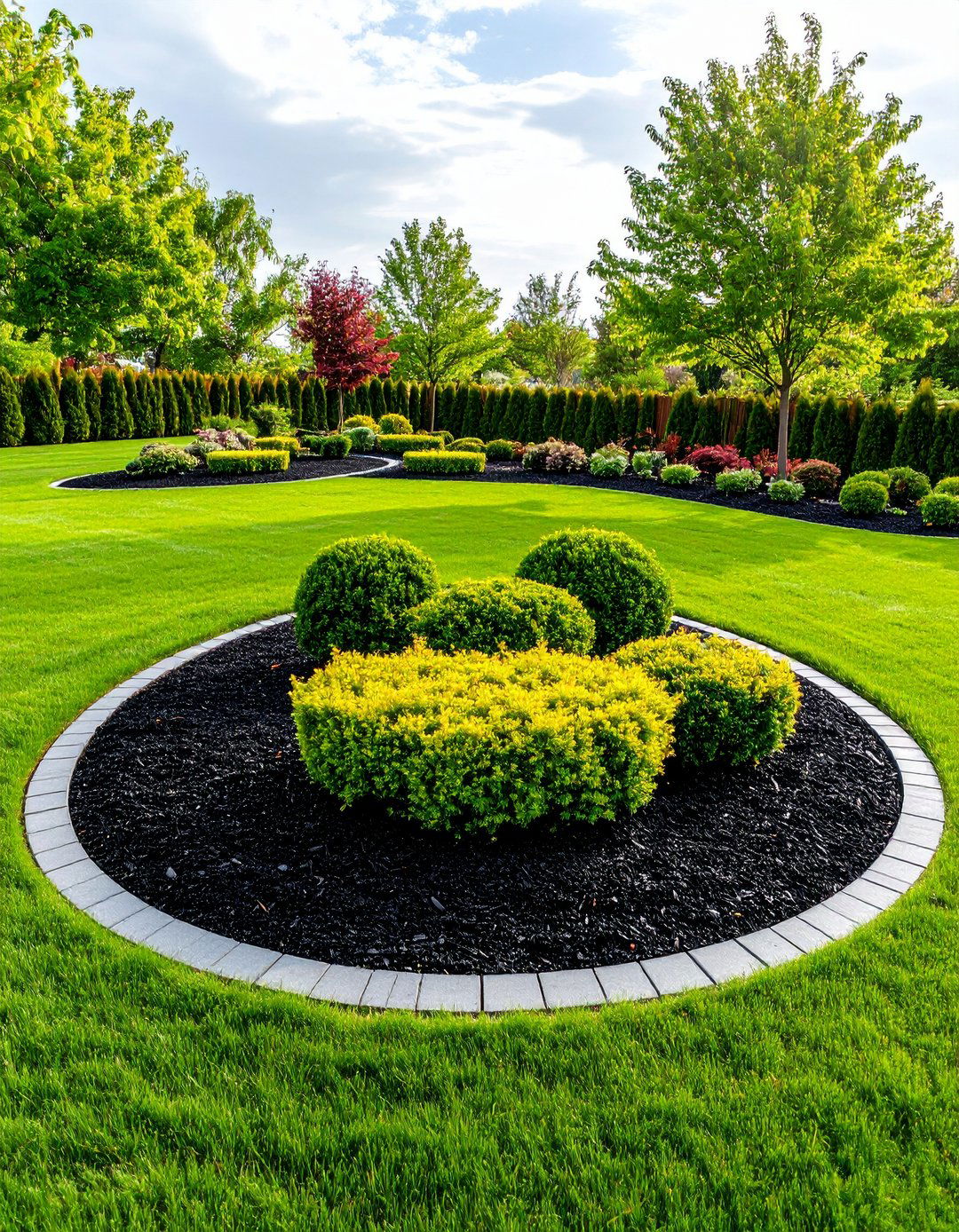
Circular or kidney-shaped island beds anchored by black mulch break up a sea of grass yet shrink mowing time. By consolidating shrubs and perennials into one mass, you reduce edging labor, and the dark mulch blocks volunteer turf runners effectively. Outline with a spade-cut trench or recycled plastic edging, then mulch eight to ten centimeters deep the first year; afterward, a thin color-boosting top-up is all that’s needed.
19. Shrub-Lined Living Fence with Weed-Suppressing Black Mulch
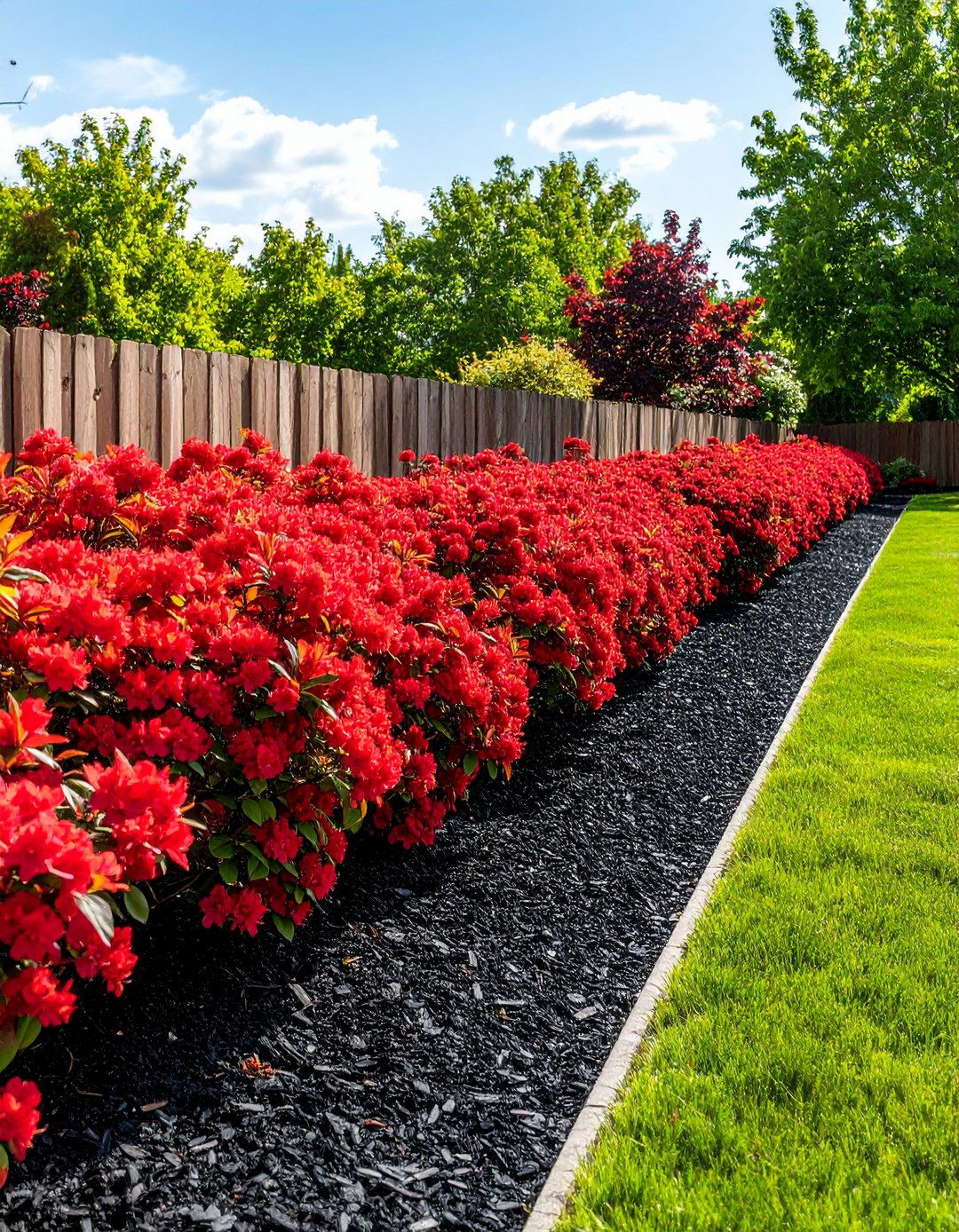
Dense hedges of viburnum or photinia demand clear soil to avoid competing vines. A continuous swath of dark mulch two meters wide across the hedge base denies light to germinating weeds and traps irrigation where roots spread widest. Check depth annually with a ruler—over-mulching can invite stem rot—and pull mulch back five centimeters from trunks for airflow. The crisp black band doubles as a maintenance path for pruning day.
20. Instant Curb-Appeal Refresh: Re-Dye or Top-Dress Faded Black Mulch
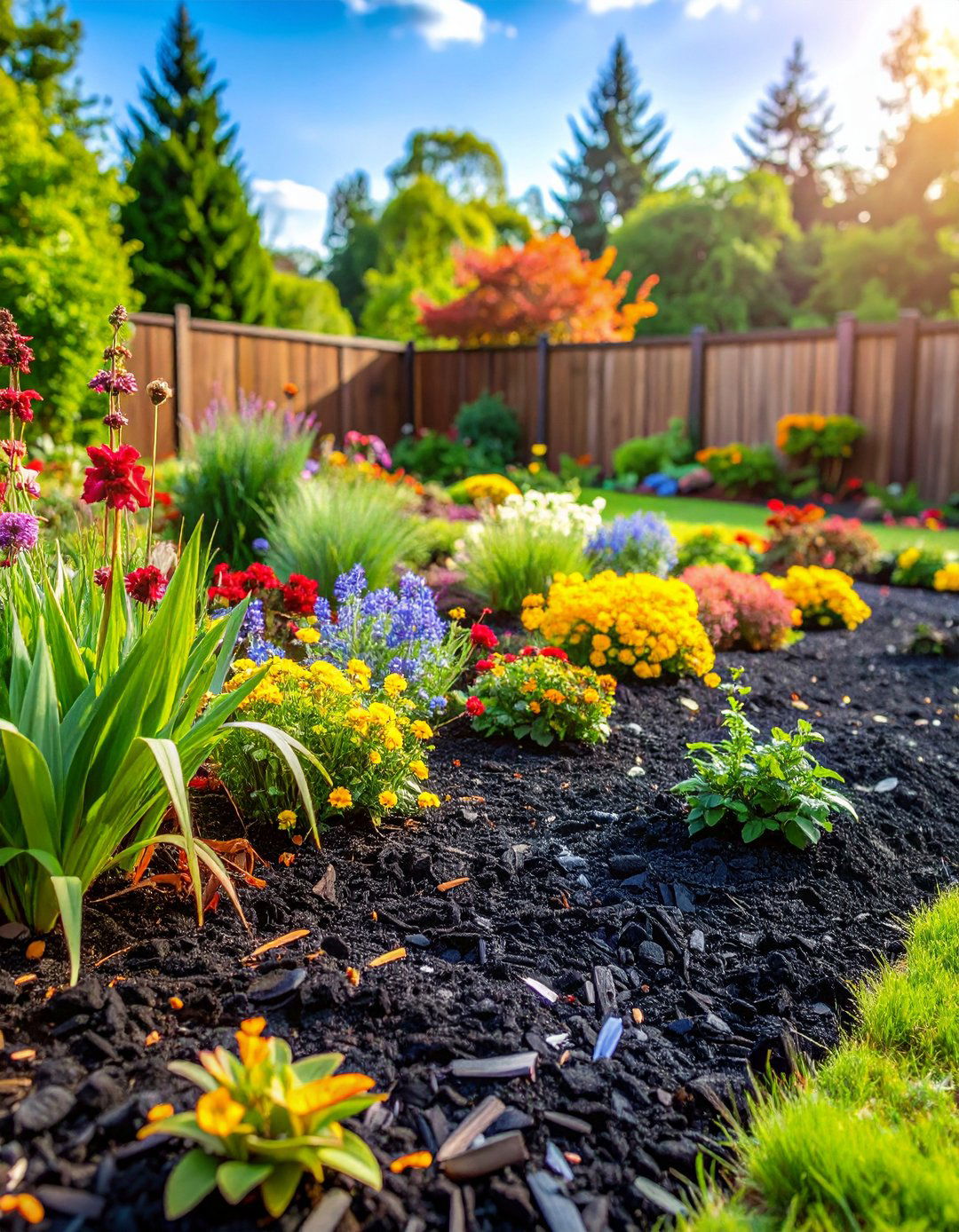
Black mulch inevitably grays under UV and rainfall. Instead of replacing the full layer, rake it level, remove debris, then add a one-inch cap of fresh chips or spray an eco-tint formulated for mulch to restore the inky finish. Pressure-wash bordering hardscape afterward for a professional, just-installed look, and schedule the refresh each spring so the landscape sparkles ahead of peak growing season.
Conclusion:
Black mulch proves its worth far beyond aesthetics: it locks in moisture, deters weeds, moderates soil temperatures, and offers striking visual contrast that elevates every design style—from minimalist gravel mosaics to kid-friendly chalkboard beds. By matching texture, depth, and maintenance routines to each planting scenario, you harness those benefits while avoiding pitfalls like over-mulching or dye fade. Whether you’re stabilizing a slope, framing a hydrangea hedge, or simply refreshing last year’s beds, the deep, dark backdrop remains a reliable, sustainable tool for healthier plants and head-turning curb appeal.


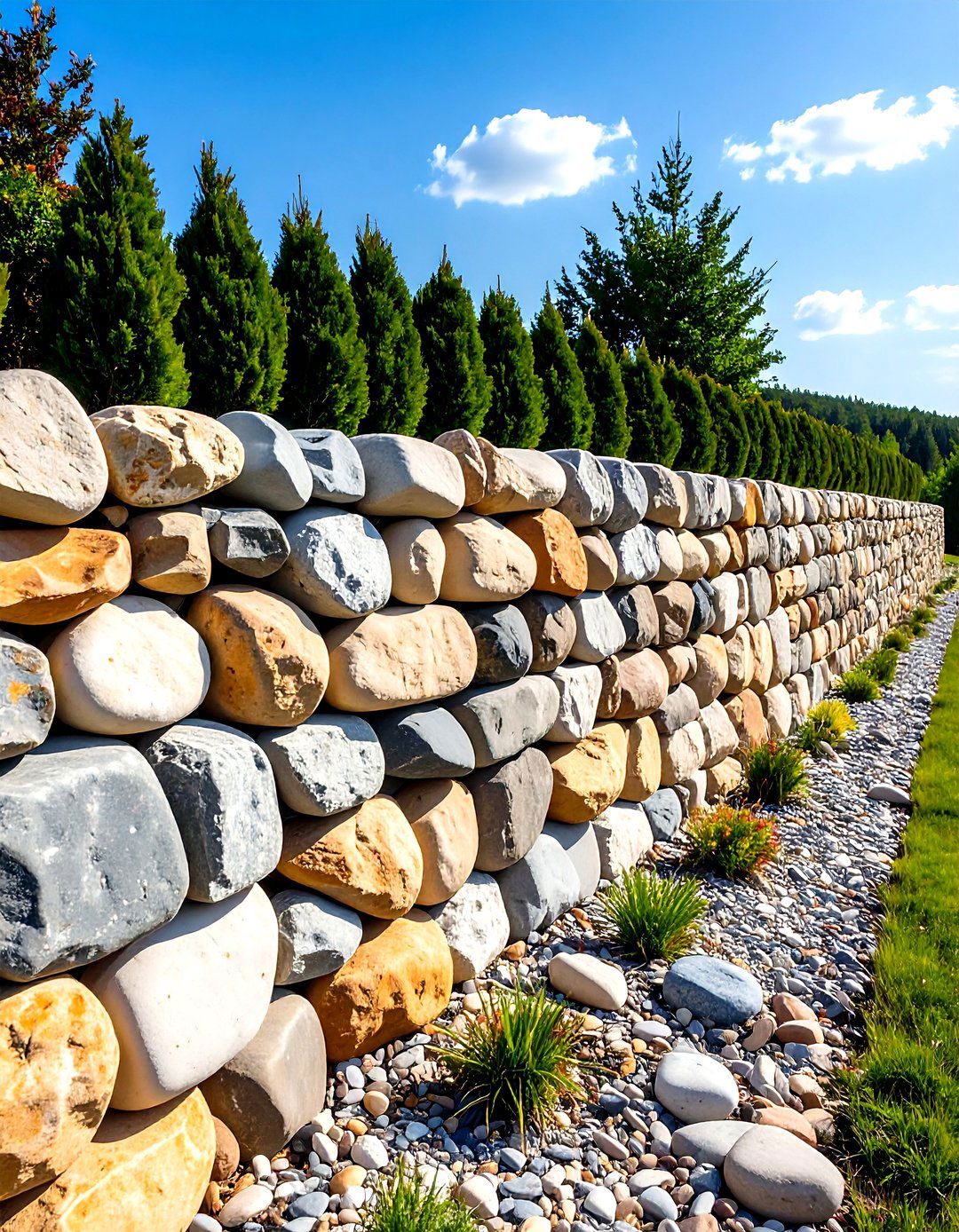
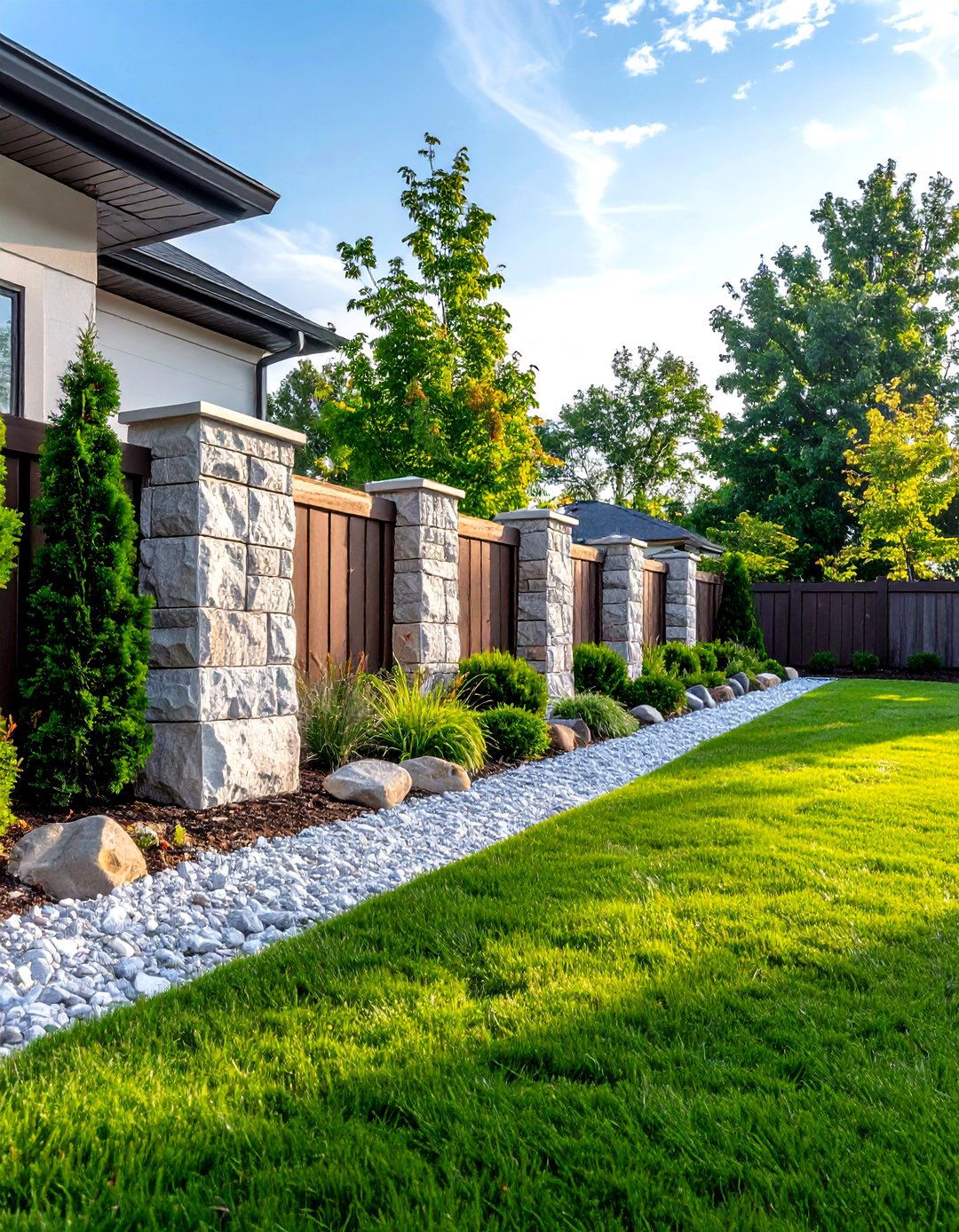
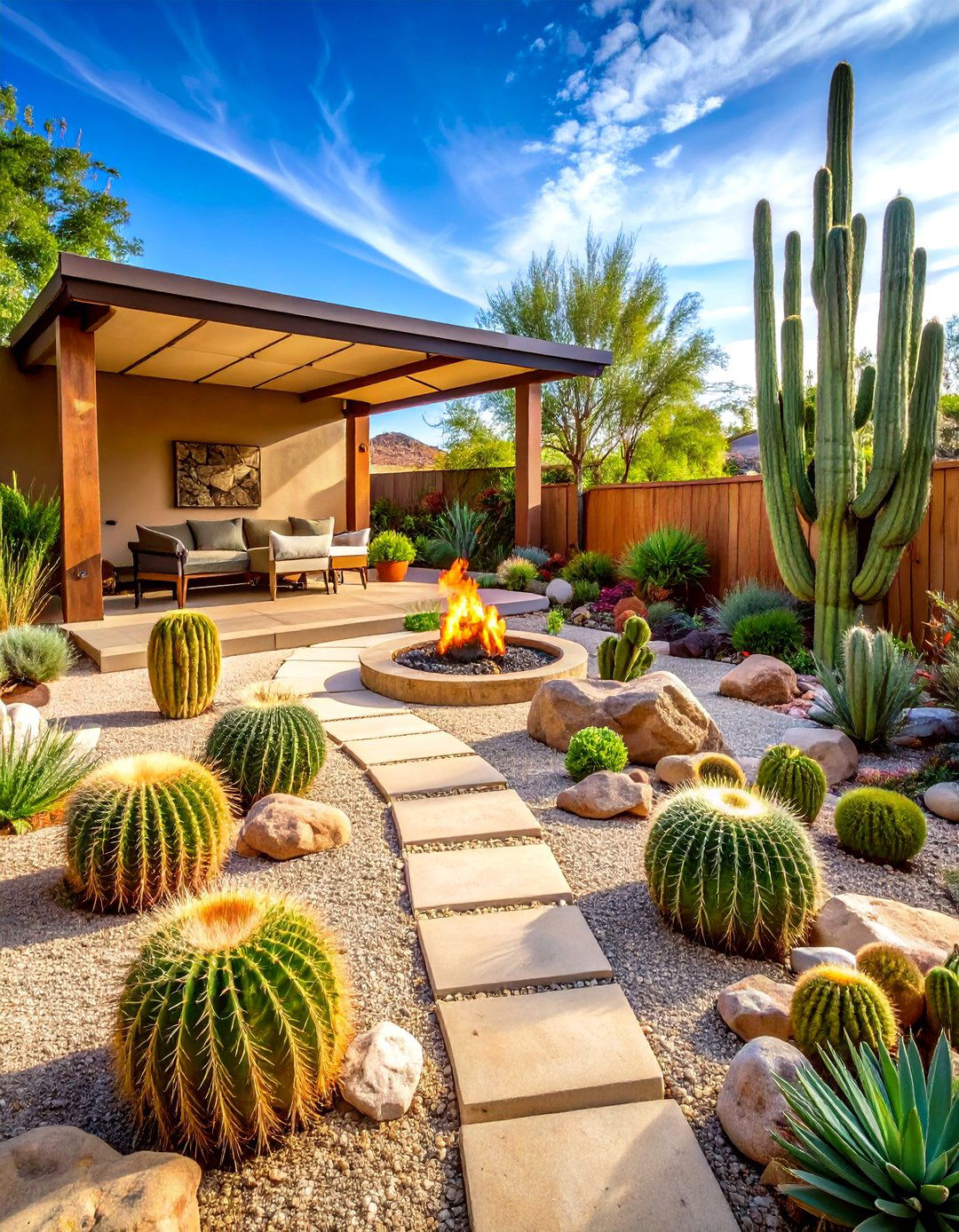
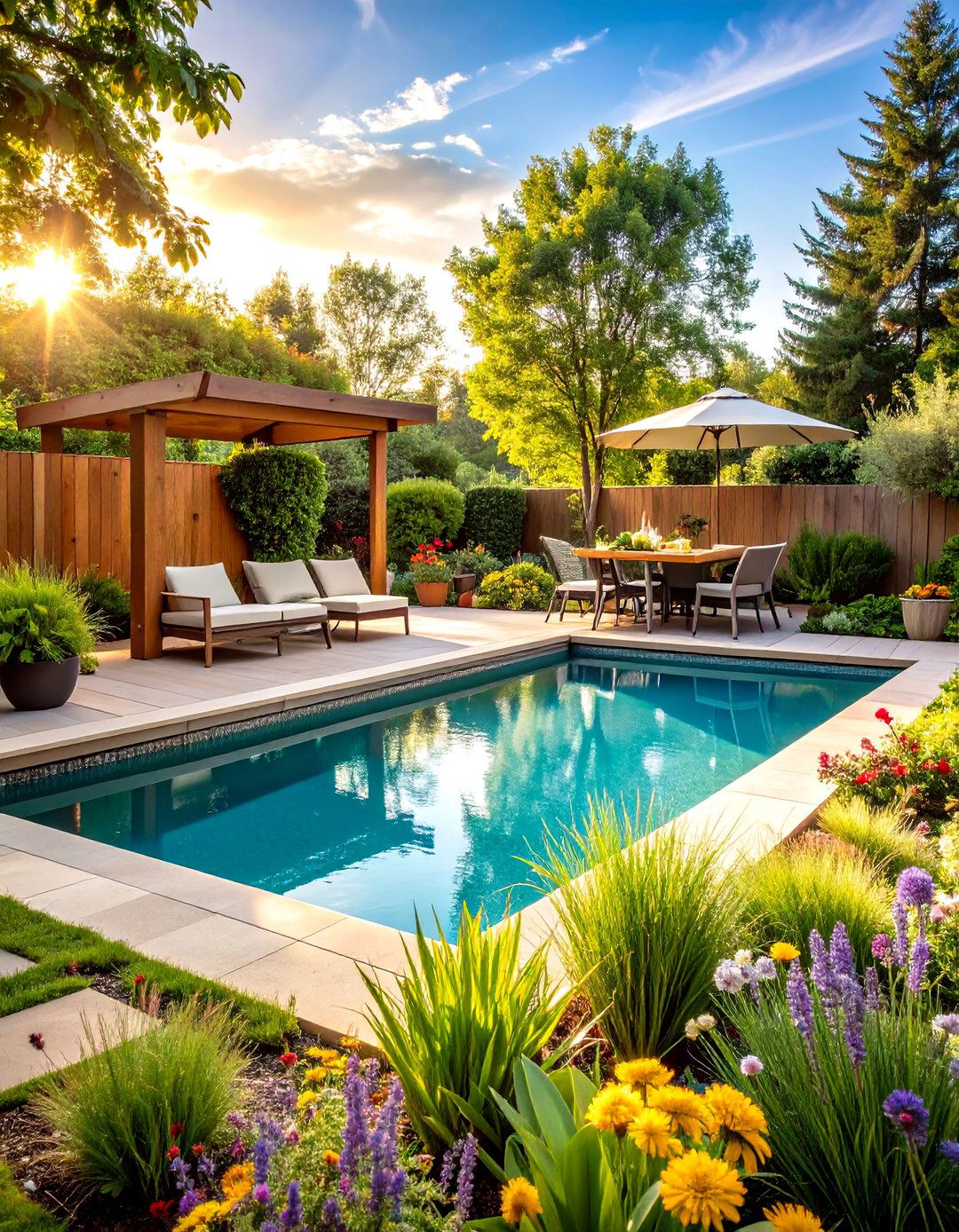


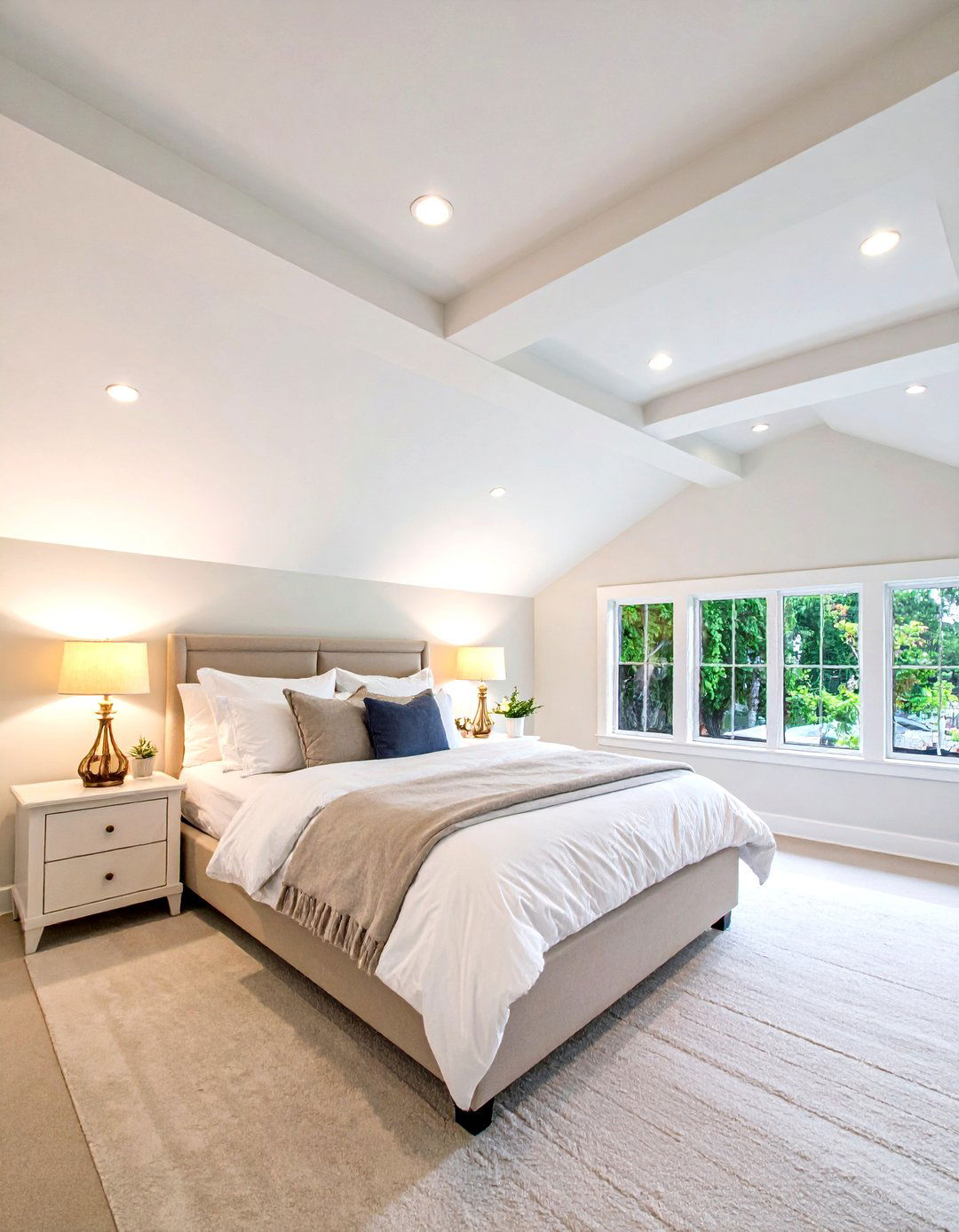
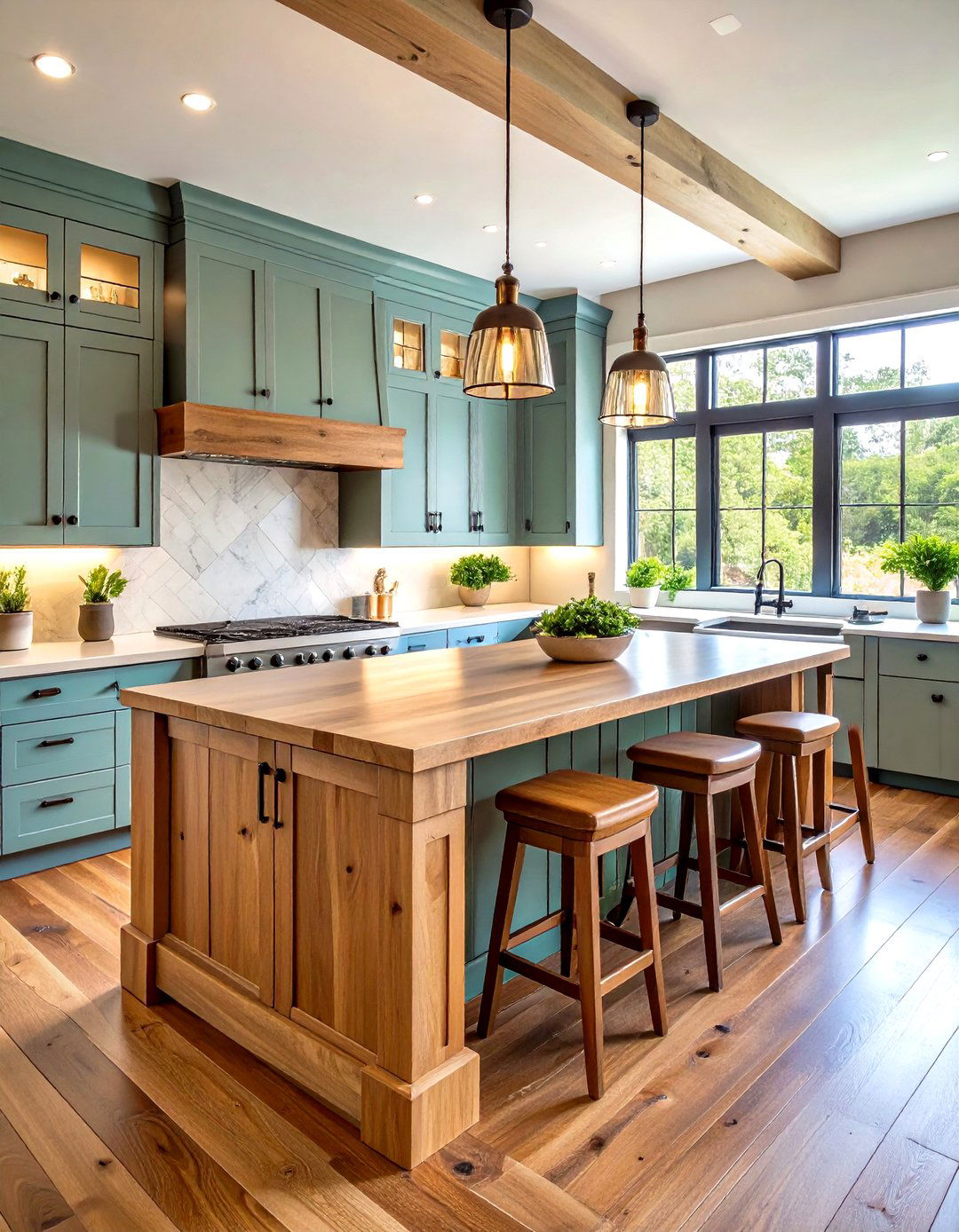
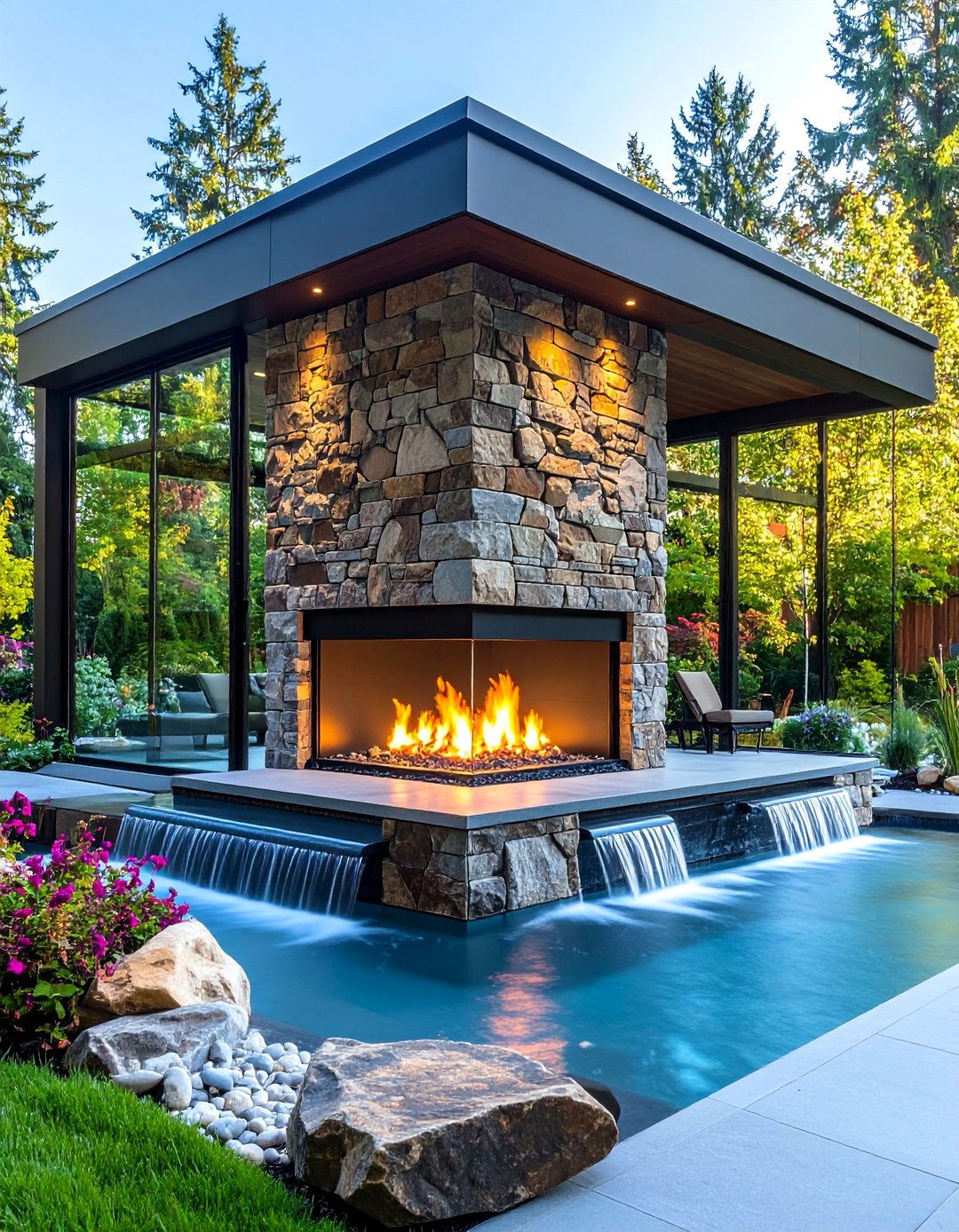
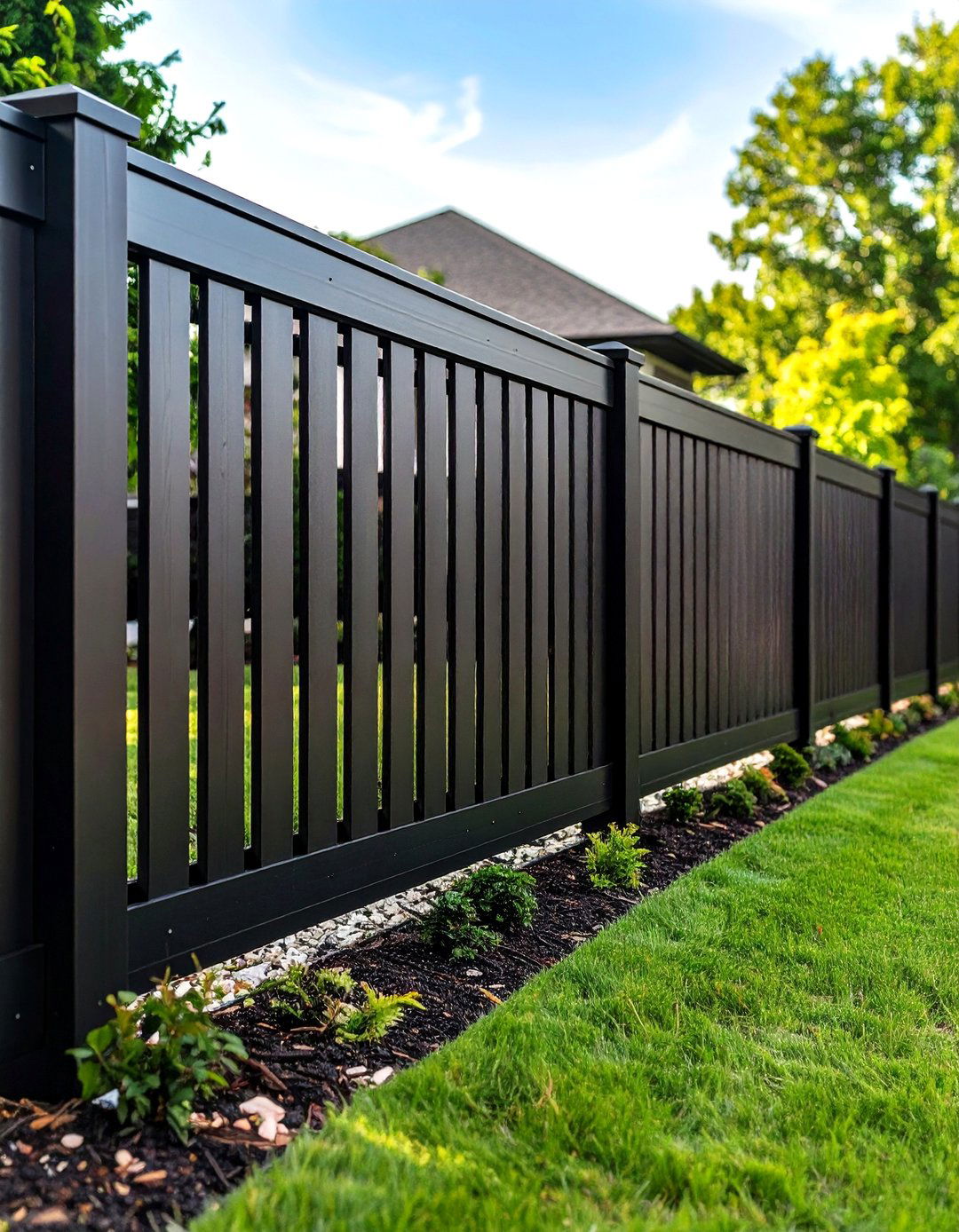


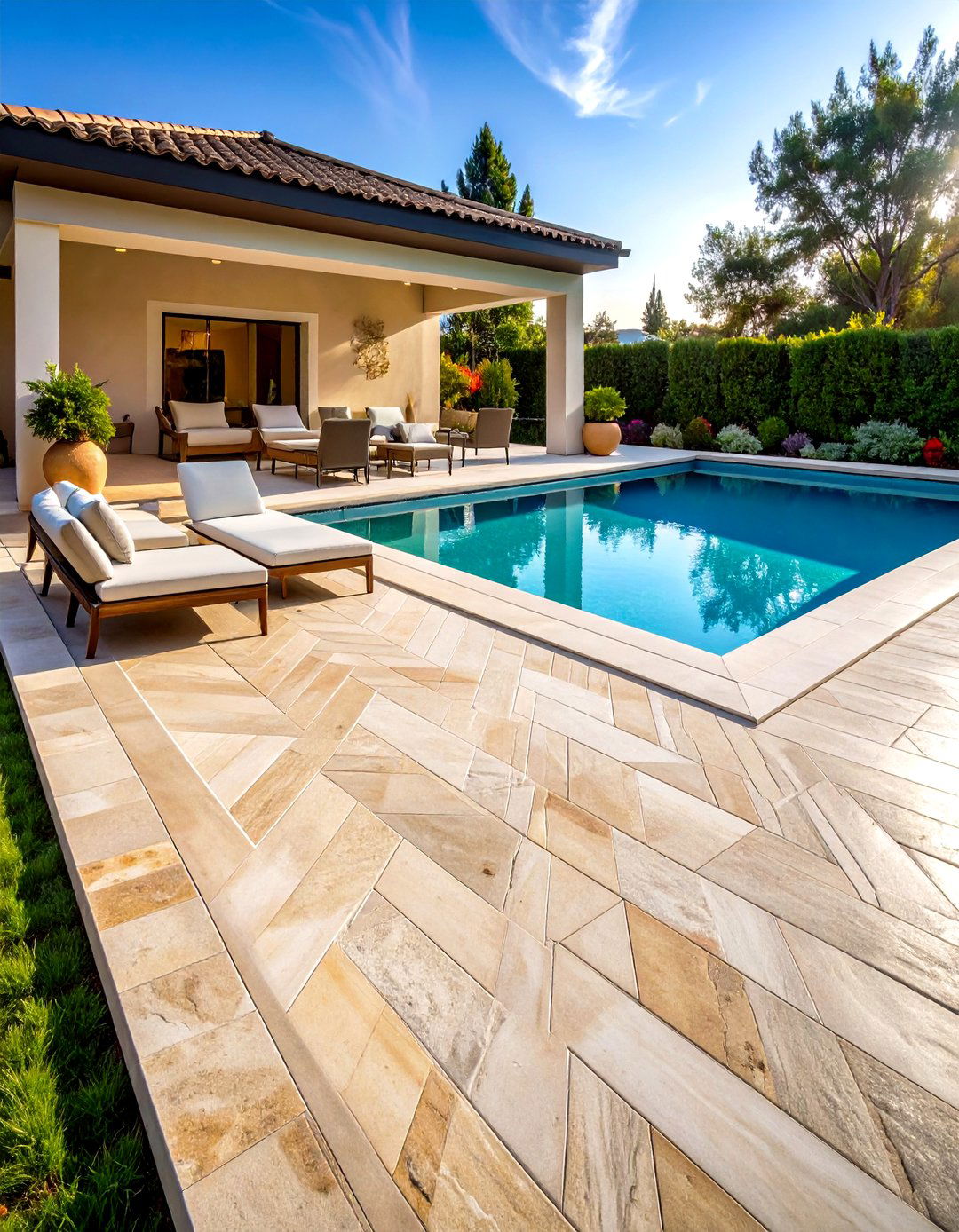
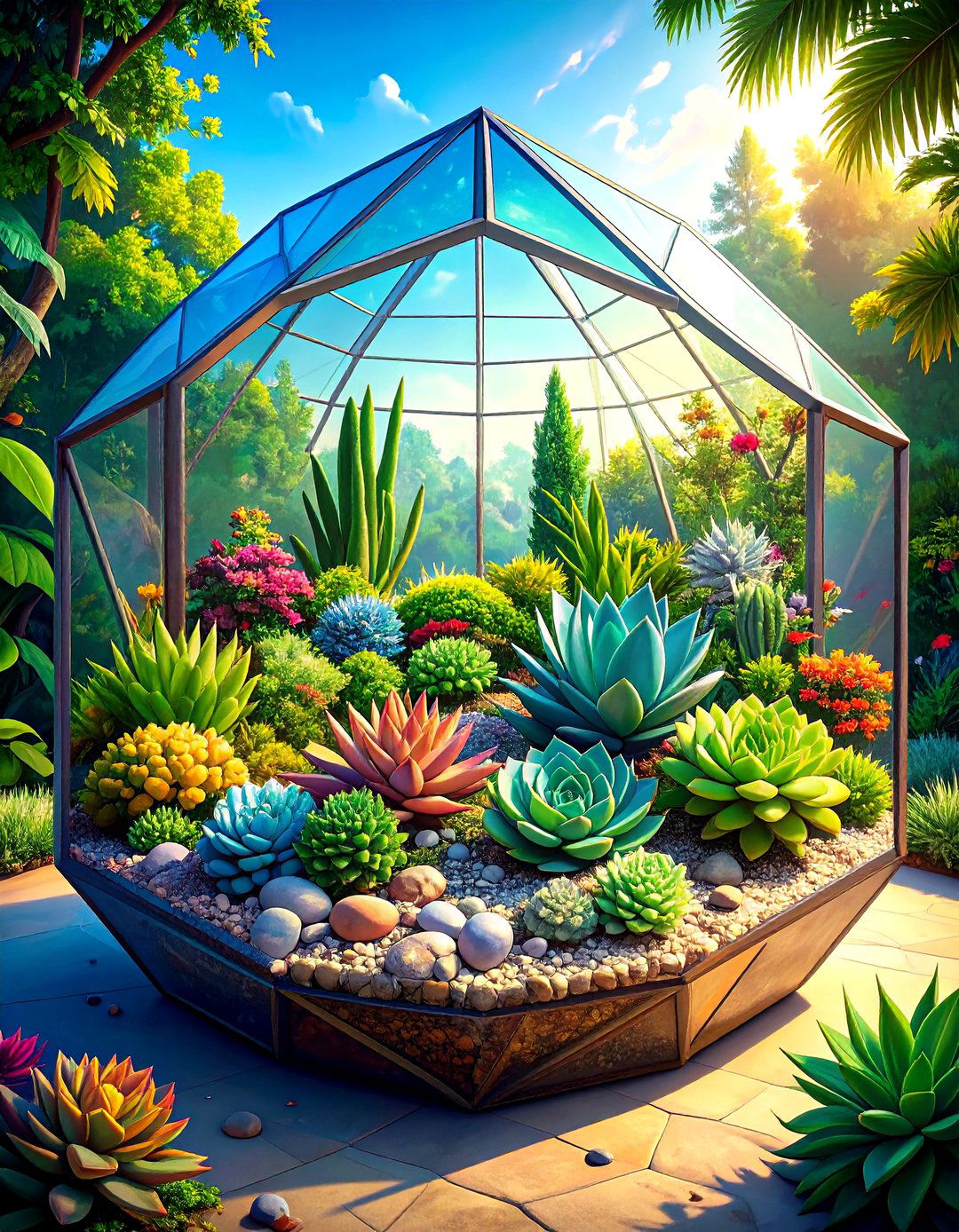
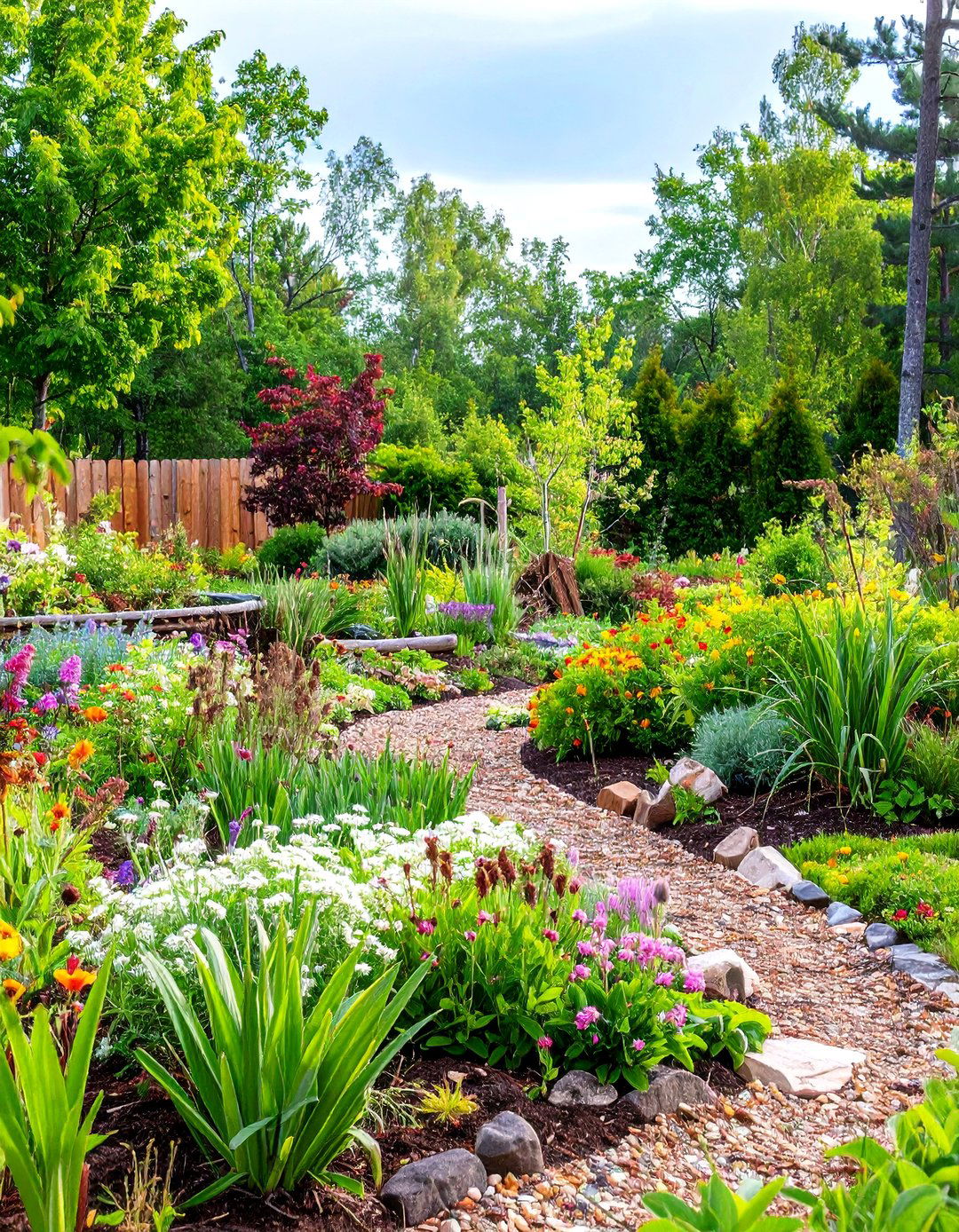
Leave a Reply